2. 中国地质大学(北京)地球科学与资源学院, 北京 100083
2. School of Earth Sciences and Resources, Chinese University of Geosciences, Beijing 100083, China
俯冲带形成在两个岩石圈板块相向运动过程中,通过俯冲作用,一个岩石圈沉降到另一个岩石圈之下。因此,俯冲带是岩石圈不对称沉进地幔的三维区域,是地球上约55000km长的汇聚板块边缘的深部表现形式,它从地表一直延伸到深地幔,甚至核-幔边界(图 1、图 2; Stern, 2002; Zheng and Chen, 2016)。一般情况下,仅大洋岩石圈可以俯冲到地幔深度,并重新结合进地幔。而大陆地壳物质由于密度较小,通常不能俯冲到很大深度。在俯冲带,岩石圈的下沉提供了板块运动所需要的主要牵引力,并引起上覆地幔楔对流和洋中脊扩张。地球上的许多重要地质作用发生在俯冲带,如地壳物质和挥发份再循环进地幔、火山链和许多大型矿床的形成、新生地壳和大陆的产生、地球上最强烈的地震等。
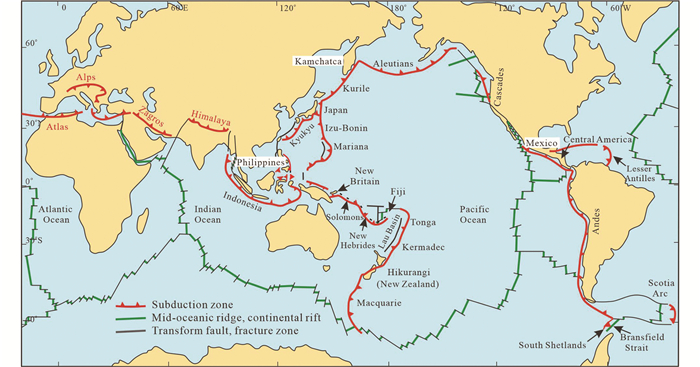
|
图 1 全球俯冲带位置图(据Stern, 2002;Frisch et al., 2011) 全球汇聚板块边缘长约55000km,略短于大洋中脊长度(60000km).汇聚板块边缘包括正常的俯冲带和大陆碰撞带(Atlas, Alps, Zagros和Himalaya) Fig. 1 Subduction zones and convergent plate margins (after Stern, 2002; Frisch et al., 2011) |
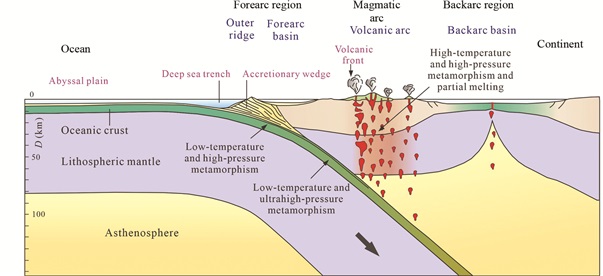
|
图 2 俯冲带上部150km简化剖面图(据Frisch et al., 2011修改) 俯冲带是地幔中的一个区域,在这里大洋岩石圈下沉,并伴生有地震、变质作用、流体释放、诱发的地幔对流、部分熔融和弧岩浆作用 Fig. 2 Schematic section through the upper 150km of a subduction zone (modified after Frisch et al., 2011) |
俯冲带最重要的特征之一就是强烈的岩浆作用,现今地球上的火山作用大多发生在大洋岩石圈(太平洋板块)俯冲带。俯冲板片含水矿物释放的含水流体在俯冲带岩浆形成过程中起到了关键作用,因为水可以大大降低岩浆源区的固相线温度。关于俯冲带岩浆岩的形成机制还存在争议。一种可能的机制是俯冲洋壳中的玄武质洋壳发生含水部分熔融(Nicholls and Ringwood, 1972; Kay, 1980; Wyllie and Sekine, 1982)。含水玄武质体系的熔融实验表明,玄武质地壳的含水熔融主要形成酸性岩浆,并具有英云闪长岩或埃达克岩成分特征(Beard and Lofgren, 1991; Rushmer, 1991; Wolf and Wyllie, 1994; Rapp and Watson, 1995)。有关俯冲带热结构的分析与数值模拟结果表明,只有相对年轻的、热的大洋岩石圈俯冲才能发生部分熔融,而老于20Ma的俯冲洋壳不可能在弧下深度发生部分熔融(Drummond and Defant, 1990; Molnar and England, 1995; Bourdon et al., 2002)。另一种机制是俯冲板片脱流体反应释放的流体诱发地幔楔含水部分熔融(McBirney, 1969; Tatsumi et al., 1983)。这被认为是更可能的机制,因为大量的地球物理、地震学、岩石学和热力学模拟均表明,正常的俯冲带是冷的,具有比上覆地幔楔明显低的温度。所以,在地壳岩石俯冲过程中会经历低地热梯度下的高压到超高压变质作用和伴生的连续脱水过程。即使是在板片俯冲到>80km的弧下深度时,脱水的地壳岩石也达不到部分熔融温度。
尽管大多数研究认为,形成在俯冲带(汇聚板块边缘)的岩浆岩大多起源于受俯冲板片流体交代的地幔楔。但是,当年轻的和热的大洋岩石圈发生俯冲时、扩张的洋中脊发生俯冲时、俯冲板片受到流体交代时,俯冲的地壳岩石也会发生部分熔融。俯冲板片是否发生部分熔融取决于俯冲带的热结构和含水性。本文在对俯冲带基本类型、热结构与含水性进行概述的基础上,对俯冲板片部分熔融作用与动力学机制进行了全面总结。
1 俯冲带的基本类型地球上存在四种类型的汇聚板块边缘(Frisch et al., 2011)。第一种类型为洋内俯冲带,即一个大洋岩石圈俯冲到另一个大洋岩石圈之下,由此形成一个发育在洋壳之上的火山弧系统,即硅镁层上的岛弧。如位于太平洋板块西缘的马里亚纳群岛弧,大西洋的小安得列斯群岛弧(图 3a)。第二种类型是大洋岩石圈俯冲到大陆岩石圈之下,形成一个发育在大陆地壳之上的岛弧,即硅铝层之上的岛弧。这样的岛弧系统与大陆之间被弧后盆地分隔,如日本岛弧和东圣达弧(图 3b)。第三种类型汇聚边缘是活动大陆边缘,即大洋岩石圈俯冲到大陆岩石圈之下,所形成的岩浆弧位于大陆边缘,弧与陆之间没有大洋盆地,如安第斯、阿拉斯加和爪哇岩浆弧等(图 3c)。第四种类型为大陆碰撞带。当两个大陆在俯冲过程中发生碰撞,它们最终将融合到一起。两个板块之间的强烈挤压和俯冲大陆的浮力会导致碰撞带俯冲作用的停滞。在大陆碰撞过程中,大洋岩石圈部分将发生撕裂并继续下沉,即板块断离作用(图 3d)。陆-陆碰撞最终会导致巨型山脉的形成,如喜马拉雅和阿尔卑斯山。

|
图 3 地球上不同类型的俯冲带和汇聚板块边缘(据Frisch et al., 2011修改) (a)马里亚纳岛弧形成在洋壳之上;(b)日本岛弧形成大陆地壳之上;(c)安第斯火山带形成在南美大陆之上(活动大陆边缘);(d)两个大陆碰撞形成山脉,如喜马拉雅山,随着俯冲结束,板块断离 Fig. 3 Examples of different types of plate margins with subduction zones (modified after Frisch et al., 2011) |
环太平洋俯冲带是研究俯冲带岩浆作用、变质作用和成矿作用的典型地区,可以划分为两种端元类型(图 4; Stern, 2002; Zheng and Zhao, 2017)。一种是马里亚纳型,位于太平洋板块西北边缘,其俯冲的大洋岩石圈具有古老、厚、冷和密度大的特征。这样的岩石圈易发生快速俯冲,形成陡的冷俯冲带(图 4a);另一种类型是智利或安底斯型,位于南美板块边缘,俯冲的大洋岩石圈具有年轻、薄、热和轻的特征。这样的岩石圈不易俯冲,所以形成速度较慢的、低角度的平缓俯冲带。这样的俯冲带具有较高的温度,是暖俯冲带(图 4b)。从构造变形角度来说,智利型俯冲带之上的岩浆弧处于挤压构造环境,俯冲板片与地幔之间是强烈耦合的,弧地壳明显加厚;而马里亚纳型俯冲带之上的岩浆弧处于强烈伸展环境,俯冲板片与地幔楔之间是弱耦合的,弧地壳减薄,并形成弧后盆地。Peacock and Wang (1999)和Peacock (2003)的研究表明,在老的、冷的板片俯冲过程中,俯冲板片不发生部分熔融,但其脱水所形成的流体诱发地幔楔部分熔融,形成正常的弧岩浆岩;而在年轻的、热的板片俯冲过程,俯冲洋壳有可能发生部分熔融,形成埃达克岩。
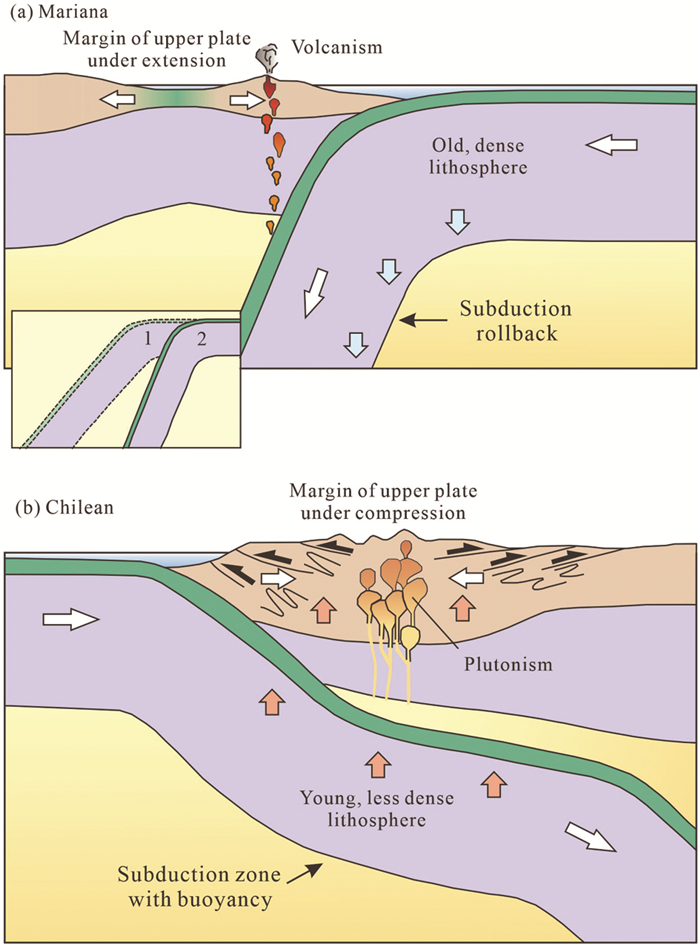
|
图 4 环太平洋俯冲带的两种端元类型(据Frisch et al., 2011修改) (a)马里亚纳(Mariana)型;(b)智利(Chilean)型.在马里亚纳型俯冲带,俯冲作用很容易发生,古老且密度大的岩石圈易发生回转(插图).在智利型俯冲带,年轻的且密度低的岩石圈向上运动,被迫发生俯冲作用 Fig. 4 Two types of subduction zones in circum-Pacific plate (modified after Frisch et al., 2011) |
研究表明,俯冲带热结构的影响因素包括:俯冲速率和角度、上覆板片的运动速度和厚度、俯冲板片的年龄、厚度和宽度以及俯冲板片与地幔的耦合程度(Zheng and Chen, 2016)。汇聚速率是控制俯冲带热结构的重要因素,汇聚速率降低,俯冲板片与上覆地幔界面的温度增加,汇聚速率加快,板片与地幔界面的温度降低。一般情况下,大陆俯冲带是冷体制,而大洋俯冲带可以是冷的,也可以是热体制。从构造上说,如果俯冲板片与地幔楔是耦合的,俯冲板片表面将会保持较低温度,如果板片与地幔楔之间是解耦的,俯冲板片表面将会具有较高的温度。因此,俯冲带的热结构是变化的,可以从俯冲早期的冷体制,变化到晚期的暖体制,甚至热体制。总体上,俯冲板片具有比两边地幔明显低的温度,对于冷俯冲带来说,在60~100km的深度,俯冲板片与地幔楔界面的温度为550~650℃。
形成在俯冲带的高压和超高压变质岩可以为揭示俯冲带的深部组成与热结构特征提供直接证据。近几年来,有许多学者对变质岩在峰压力下的P-T条件(Pmax-T)和进变质P-T轨迹与动力学模拟预测的俯冲带P-T轨迹进行了比较研究(Penniston-Dorland et al., 2015)。对比结果表明,尽管模拟的俯冲带热结构范围包括了从大多数变质岩中得到的Pmax-T条件,但模拟预测的平均温度要比变质岩记录的低(图 5)。当Pmax < 20kbar时,二者的偏差较大,仅少量温度最高的模拟轨迹与岩石学结果吻合,模拟的平均温度比岩石记录的低100~300℃(图 5)。相关研究者认为二者之间的明显差异很可能是由于最近的俯冲带热模拟没有考虑到可能存在的其它重要热源,如俯冲板片与地幔楔界面之间的剪切热。
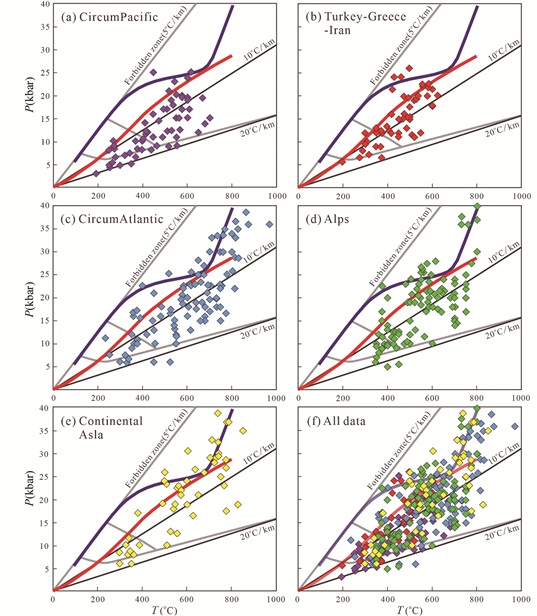
|
图 5 高压和超高压变质岩形成条件与模拟预测的俯冲带平均P-T条件对比图(据Penniston-Dorland et al., 2015) 图中红线表示Gerya et al. (2002)的模拟结果,紫线为Syracuse et al. (2010)的模拟结果.在P>25kbar,模拟预测的和变质岩估算的P-T条件吻合较好;但在较浅深度(< 20kbar),变质岩所记录的P-T条件要比模拟预测的更热(多大于200℃) Fig. 5 Comparison of P-T conditions estimated by high-pressure and ultrahigh-pressure metamorphic rocks to average model P-T predictions (after Penniston-Dorland et al., 2015) |
岩石学研究表明,在大洋板块俯冲过程中,以水为主的流体会逐渐从岩石中脱离出去。也就是说,俯冲带中的流体随着俯冲作用的进行会逐渐减少。在较浅部,岩石中的孔隙流体通过压实作用被逐渐排出,在较深部的脱水是通过含水矿物的分解作用。在大洋岩石圈俯冲过程中,随着压力和温度增加,含水矿物角闪石、黝帘石、硬绿泥石、绿帘石、蛇纹石、硬柱石和多硅白云母依次发生脱水(图 6; Schmidt and Poli, 1998; Scambelluri and Philippot, 2001; Grove et al., 2012)。黝帘石和硬绿泥石的脱水深度在100~120km,大致与岩浆弧下深度相当,而硬柱石和多硅白云母的脱水深度可达300km。这表明,尽管俯冲洋壳会在弧下或更浅部发生明显脱水,失去岩石中的大部分水,但也有一部分水通过含水矿物或以名义上无水矿物中的结构水形式被带入到深部地幔。Hacker (2008)的相平衡模拟与计算表明,在冷俯冲带,MORB、辉长岩、粘土岩、沉积岩和泥质岩可以将2.5%~5.2%的水携带到约40kbar的深度,橄长岩和蚀变的亏损地幔可以携带~8%-12%的H2O到40kbar的深度,而硅质岩和花岗质片麻岩只能将少量(< 1%)的水带到40kbar的深度(图 7);在热俯冲带,MORB、辉长岩、橄长岩和亏损地幔俯冲到40kbar深度时,几乎失去全部水,而粘土岩、沉积岩、泥质岩和花岗质片麻岩可将少量(0.5%~1.5%)的水带入到40kbar的深度(图 7)。在冷俯冲带,变质交代的洋壳、大洋火山岩、大洋沉积岩和大陆地壳中的泥质岩石都可以将相当多的水带入到超过弧下深度的更深地幔中。
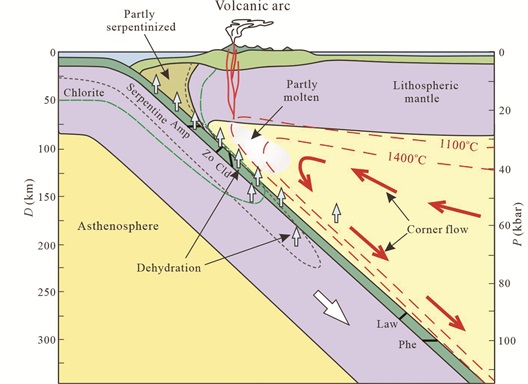
|
图 6 俯冲大洋岩石圈流体释放示意图(据Frisch et al., 2011修改) 在俯冲带,橄榄岩和上覆基性地壳的脱水是通过含水矿物的分解从地表至300km深度连续发生.白色箭头指示流体流动方向.图中表示有绿泥石(绿色虚线)和蛇纹石(黑色虚线)在俯冲带中的稳定域,以及角闪石(Amp)、绿帘石(Zo)、硬绿泥石(Cld)、硬柱石(Law)和多硅白云母(Phe)在俯冲洋壳中的分解位置 Fig. 6 Model for fluid release from the subducting lithosphere (modified after Frisch et al., 2011) |

|
图 7 俯冲岩石的P-T相图和水含量关系图(据Hacker, 2008) (a) MORB;(b)辉长岩;(c)橄长岩;(d)礈石岩;(e)粘土岩;(f)沉积岩;(g)蚀变的亏损地幔;(h)泥质岩;(i)花岗质片麻岩.图中显示有冷、热俯冲带的P-T轨迹,相应岩石的饱和水固相线(虚线)与脱水熔融固相线(实线) Fig. 7 Phase diagrams for unmetasomatized oceanic crust, oceanic sediments, oceanic mantle and continental rocks, showing P-T paths of the cold and hot subduction zones and changes of water contents (after Hacker, 2008) |
20世纪80年代以来,地球化学与岩石学家大多认为,在现代岩浆弧,俯冲物质的部分熔融应该是比较少见的,或不会发生。这主要基于以下三方面证据,第一,很少有弧岩浆岩显示出强烈的HREE/MREE亏损。这样的亏损应该是俯冲带榴辉岩或石榴角闪岩部分熔融所形成熔体的特征(Gill, 1974, 1978; Rapp et al., 1999; Kelemen et al., 2003a)。此外,如果俯冲物质发生部分熔融,所形成的熔体很可能是花岗质的(Nichols et al., 1994; Rapp and Watson, 1995; Rapp et al., 1999; Johnson and Plank, 1999),在30kbar或更高压力下熔体应该是水饱和的,含有近25%~50%的H2O(Dixon and Stolper, 1995; Dixon et al., 1995; Kawamoto and Holloway, 1997; Mysen and Wheeler, 2000)。但是,没有弧岩浆岩具有在榴辉岩相条件下沉积岩或玄武岩部分熔融形成的流体饱和特征。第二,在俯冲板片中,大多数脱水反应很可能在20kbar就已经完成,因此,俯冲板片难以发生流体饱和熔融(Davies and Stevenson, 1992; Peacock et al., 1994; Rapp and Watson, 1995)。第三,从1980到2002年之间发表的热数值模拟结果均表明,正常洋壳俯冲带(汇聚速率>0.03m/y,俯冲洋壳年龄>20Ma)顶部的温度不会高于变质玄武岩或变质沉积岩的饱和流体固相线温度(Peacock et al., 1994; Peacock, 1996, 2003; Kelemen et al., 2003b)。
但是,上述三个俯冲板片不能发生部分熔融的证据都不断受到质疑。第一,榴辉岩相玄武岩和沉积岩熔融形成的亏损HREE熔体与地幔橄榄岩之间的反应模拟表明,在熔体/岩石比率 < ~0.1时,熔体中的HREE丰度可以上升到与尖晶橄榄岩平衡的水平,而LREE和其它高度不相容元素几乎不受影响(Kelemen et al., 1993, 2003b)。因此,具有平的MREE和HREE模式,低的MREE和HREE丰度,LREE富集的原始弧熔岩,很可能是俯冲物质所形成的熔体与上覆地幔楔之间反应的产物(Kelemen, 1986, 1990, 1995; Kelemen et al., 1993, 2003b; Grove et al., 2002, 2003)。第二,变质沉积岩和洋壳中的含水相,如绿泥石、角闪石、硬柱石、硬绿泥石、多硅白云母和黝帘石是在不同的压力下脱水,可以形成少量、但近连续的流体源区(图 6)。这样的流体来源从浅部一直到>250km都会存在。此外,俯冲板片上部地幔中的含水矿物蛇纹石和滑石可以稳定到很高的压力下,它们的脱水反应可以持续到~200km的深度。正如上面描述的,在冷俯冲带(正常俯冲带),变质交代的洋壳、亏损地幔、大洋火山岩和沉积岩都可以将相当多的水带入到弧下深度。因此,含水流体在 < 200~300km深度是存在的,可以导致俯冲板片发生注水熔融。第三,最近的动力学模拟预测的地幔楔和俯冲板片顶部的温度高于玄武岩和沉积岩流体饱和固相线温度,也高于部分含水矿物的脱水反应温度(Lambert and Wyllie, 1972; Stern and Wyllie, 1973; Nichols et al., 1994; Schmidt and Poli, 1998; Johnson and Plank, 1999; van Keken et al., 2002; Kelemen et al., 2003a; Syracuse et al., 2010; Cooper et al., 2012; Spandler and Pirard, 2013)。这表明俯冲的地壳岩石可经历在弧下深度的脱水熔融和注水熔融。
尽管目前,我们还不能确定大多数俯冲板片顶部的温度在弧下深度是否超过流体饱和的固相线温度,但是,现有的热模拟也不能排除俯冲岩石可以发生在榴辉岩相条件下的部分熔融。总之,基于上述各种理由,利用地球动力学模拟排除沉积岩、玄武岩、下地壳辉长岩在弧下深部发生部分熔融是没有充分依据的。另一方面,如果俯冲的沉积岩、玄武岩和(或)辉长岩形成的熔体作为将不相容元素从俯冲板片迁移到地幔楔的介质,可以更好地解释原生弧熔岩的地球化学特征。如,Spandler and Pirard (2013)的研究表明,蛇纹岩化岩石圈地幔脱水会导致板片注水熔融,并将俯冲板片中的元素迁移到地幔楔(图 8)。俯冲岩石圈水化后的蛇纹岩,或弧前地幔楔水化后的蛇绿混杂岩(通过俯冲剥蚀成为俯冲板片的一部分)在弧下深度会发生脱挥发份反应,由此形成的流体导致板片顶部的含柯石英多硅白云母榴辉岩发生部分熔融,所形成的熔体迁移进地幔楔,并最终贡献给弧岩浆岩。在这种情况下,尽管蛇纹岩和(或)蛇绿混杂岩是水和某些元素(如B, Cl, As, Sb)的初始源区,但含水板片熔体将控制元素从板片到弧岩浆的迁移。这一研究结果与蓝片岩和榴辉岩相变质地体的地质学特征,以及弧熔岩的关键地球化学和同位素特征总体上是一致的。
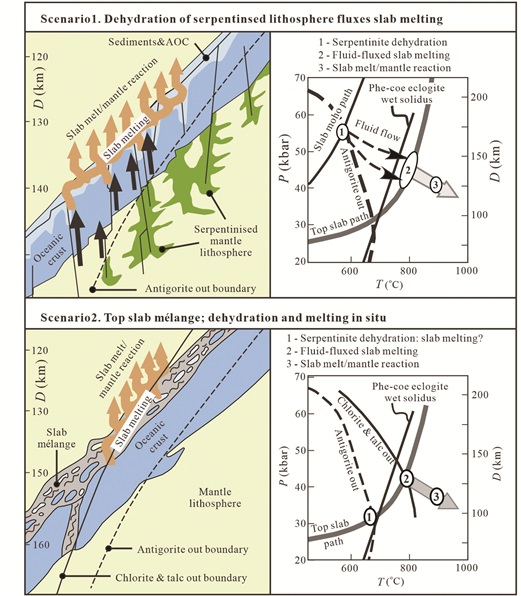
|
图 8 蛇纹岩化超基性岩和蛇绿混杂岩脱水导致俯冲板片部分熔融的成因模型(据Spandler and Pirard, 2013) 情形1:蛇纹岩化岩石圈脱水形成的流体导致板片熔融;情形2,板片顶部蛇绿混杂岩脱水导致板片熔融.左边两个图为模式图,右边两个图为流体与板片相互作用的P-T图.多硅白云母柯石英榴辉岩(代表俯冲的沉积岩和蚀变的洋壳,AOC)的熔融反应线据Hermann and Spandler (2008).板片的地热梯度是典型的洋内弧梯度(据Syracuse et al., 2010),含水矿物稳定关系据Spandler et al. (2008) Fig. 8 Petrogenetic models for slab melting via fluid derived from dehydrating serpentinised lithosphere (Scenario 1) or dehydrating top-slab mélange (Scenario 2) (after Spandler and Pirard, 2013) |
按照含水矿物脱水反应引起俯冲板片地震和脱水脆变假说,Kogiso et al. (2009)基于热动力学计算确定的橄榄岩和玄武岩体系含水相关系,以及日本东北弧最新地震资料揭示的地震结构,建立了俯冲带岩浆作用的岩石学模型(图 9)。他们认为俯冲洋壳和下覆地幔的脱水必然导致俯冲板片发生熔融,俯冲板片中的玄武质地壳部分熔融是含水大洋岩石圈俯冲的必然结果。而且,俯冲板片释放的流体也可以引起地幔楔的广泛部分熔融。此外,他们还认为地幔楔中的含水矿物仅能稳定到 < 120km的较浅部区域(图 9a),火山弧前缘的位置并不受俯冲板片脱水反应控制,而是受地幔楔流动动力学控制。此外,在超高压变质条件下(>110km),俯冲板片和地幔楔部分熔融形成的是超临界流体,在较浅部条件下,地幔楔部分熔融形成的是硅酸盐熔体(图 9b)。

|
图 9 基于俯冲温度变化估算的含水矿物和熔体稳定域(a)和俯冲带水流体、硅酸岩熔体和超临界流体分布区域(b) (据Kogiso et al., 2009) 黑色和红色箭头分别指示含水流体和硅酸岩熔体的移动方向.粗虚线为临界线边界,其下的含水流体和熔体以超临界流体形式存在. Bs-蓝片岩;EpEc-绿帘石榴辉岩;AmEc-角闪石榴辉岩.矿物代号:br-brucite; chl-chlorite; srp-serpentine (antigorite); tlc-talc Fig. 9 Stability fields of hydrous minerals and partial melt (a) and estimated possible distribution of aqueous fluid, silicate melt, and supercritical liquid (b) (after Kogiso et al., 2009) |
基于上述模型,俯冲洋壳顶部的变质沉积岩也应该发生水化和部分熔融。较早期的实验研究已经表明,俯冲洋壳基性岩的脱水与俯冲沉积岩的部分熔融发生在相同的温度条件下(Nichols et al., 1994)。此外,Duggen et al. (2007)的研究揭示,在约100km深度以上的俯冲带,变质沉积岩是以脱水为特征,而在100~130km深度,水化的变质沉积岩发生熔融。俯冲带流体由含水流体转变成熔体导致了堪察加半岛南部俯冲带弧前和后弧地区熔岩地球化学特征的剧烈变化。George et al. (2005)基于汤加-Kermadec弧变质沉积岩的P-T轨迹研究,认为变质沉积岩在(800℃和80km深度发生了部分熔融,所形成的熔体添加到地幔楔源区,导致弧熔岩具有高的10Be浓度。这被认为是俯冲板片物质贡献给弧岩浆源区的明确指示(Morris et al., 1990)。Johnson and Plank (1999)通过熔融实验揭示,俯冲沉积岩部分熔融是将Th和Be等关键性元素迁移进弧岩浆源区的有效方式。Sr-Nd-Pb-Hf同位素研究也表明,日本西南部Setouchi火山岩带的高镁安山岩是俯冲的沉积岩与蚀变洋壳部分熔融的熔体与地幔楔相互作用的产物(Tatsumi and Hanyu, 2003)。
4 大洋岩石圈热俯冲带的部分熔融俯冲带是产生构成大陆地壳富硅岩浆岩的关键位置,但是,俯冲带之上地幔楔的部分熔融不能直接形成花岗岩。因此,弧地壳中花岗岩的成因或认为是来自地幔楔原始母岩浆分离结晶作用的产物,或认为是先前结晶的原始熔体再熔融的产物。但是,在异常的热俯冲体制下,如年轻板片俯冲过程中俯冲洋壳的含水熔融(饱和水熔融)或缺水熔融(脱水熔融)也可以发生,由此形成富Na-Al的中性熔体。这样的岩浆作用有可能是形成大陆地壳的重要机制。
4.1 年轻洋壳俯冲带的部分熔融据Martin (1999)总结,在典型的现代俯冲带,俯冲岩石圈年龄>20Ma,俯冲板片是冷的,具有低的地热梯度,俯冲的洋壳在其达到含水基性岩固相线之前发生脱水,因此,当其俯冲到弧下深度时并不能发生熔融(图 10)。但俯冲洋壳所释放的富集大离子亲石元素(LILE)的流体上升到地幔楔,导致地幔楔发生变质交代和部分熔融。部分熔融的残留体由橄榄石+单斜辉石+斜方辉石组成,所形成的熔体富集HREE,具有低的La/Yb和Sr/Y比值。但是,当年轻的(< 20Ma)和热的大洋岩石圈发生俯冲时,俯冲板片具有高的地热梯度,在大量脱水前就会达到含水基性岩的固相线温度,在弧下深度发生部分熔融(图 10)。在这样的条件下,石榴石和角闪石是主要的残留相,由此形成亏损HREE的岩浆(高La/Yb比)。残余斜长石的缺失导致岩浆富Sr(高Sr/Y比)。实验岩石学表明,在这样的俯冲带P-T条件下拉斑玄武质岩石熔融形成的熔体具有埃达克质成分特征。较早期的研究也表明,在年轻的(< 20Ma)和热的洋壳发生俯冲时,是俯冲的洋壳,而不是地幔楔橄榄岩发生部分熔融,由此形成埃达克质岩浆(Kay, 1978; Defant and Drummond, 1990; Rapp and Watson, 1995)。如在智利南部,智利洋脊发生俯冲形成埃达克质熔岩,这与俯冲的大洋岩石圈具有年轻的年龄是一致的。
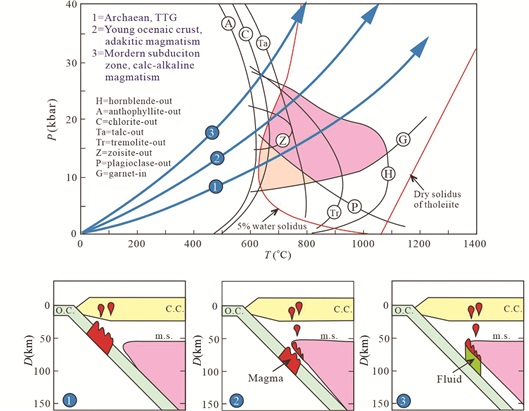
|
图 10 俯冲带的P-T图(上)与剖面图(下)及弧岩浆成因(据Martin, 1999) (1)沿俯冲板片表面(Benioff面)的地温梯度很高,俯冲板片在浅部发生熔融,斜长石作为残留相.由于地幔楔的厚度较小,温度较低,岩浆与地幔之间的相互作用有限或缺失.太古代的TTG很可能形成在这样的俯冲带环境;(2)沿俯冲板片表面的温度较高,可以使俯冲板片在较大深度下发生熔融,并且斜长石不是残留相.地幔楔是厚的和热的,岩浆与地幔之间发生相互作用.这种条件在稀少的情况下(年经的热洋壳俯冲)可以实现,形成埃达克质岩浆岩;(3)沿着俯冲板片表面的地温梯度低,俯冲板片在它开始熔融之前发生脱水.脱水反应释放的含水流体上升进入地幔楔,促使地幔楔发生变质交代和熔融,形成典型的弧型钙碱性岩浆岩.这样的条件在现代俯冲带广泛存在. P-T图中干的和含5%水的固相线分别据Wyllie (1971)和Green (1982).大洋岩石圈主要脱水反应是:H=hornblende-out;A=anthophyllite-out;C=chlorite-out;Ta=talc-out;Tr=tremolite-out;Z=zoisite-out.石榴石和斜长石的稳定线分别用G和P表示.图中的粉红色P-T域为含水拉斑玄武岩部分熔融形成的、与含角闪石和石榴石残留体共生的岩浆液体区域.太古代的俯冲带俯冲板片表面地热梯度(1)据Martin (1986),现代俯冲带板片表面地热梯度(2)和(3)分别据Toksöv et al. (1971)和Peacock et al. (1994).剖面图中O.C.=洋壳,C.C.=大陆地壳,m.s.=含水地幔的固相线;红色区域=岩浆,绿色区域=流体 Fig. 10 P-T diagram (upper) and synthetic cross-section (lower) of subduction zones, showing the conditions of genesis of arc magmas (after Martin, 1999) |
埃达克岩是一种中-酸性岩石,具有高的Na2O含量,K2O/Na2O=0.5,高的Sr含量(>300×10-6,甚至2000×10-6),具有分异的REE模式,非常低的HREE含量(Yb≤1.8×10-6, Y≤18×10-6)。因此,高的Sr/Y和La/Yb比是埃达克质岩浆岩的典型判别特征。这表明在基性岩熔融过程中石榴石和(或)角闪石是残留相。埃达克岩具有比正常钙碱性岩浆岩更高的Mg值(0.5),Ni(20×10-6~40×10-6)和Cr(30×10-6~50×10-6)含量。这可以用俯冲板片产生的埃达克质岩浆在上升过程中与地幔楔发生相互作用来解释。
目前世界上已有几个俯冲洋壳发生部分熔融形成奥长花岗岩-英云闪长岩的报道,如Catalina(Sorensen and Barton, 1987)、古巴(García-Casco et al., 2008; Lázaro and García-Casco, 2008)、伊朗北部(Rossetti et al., 2010)和智利Patagonia(Angiboust et al., 2017)。这些已知的含熔体的俯冲洋壳都相当于沿进变质P-T轨迹发生变质和熔融形成的浅俯冲岩石,表明年轻的大洋岩石圈俯冲过程中可以发生部分熔融(Angiboust et al., 2017)。García-Casco et al. (2008)研究表明,在古巴的Sierra del Convento蛇绿混杂岩中,由MORB变质形成的绿帘石石榴石角闪岩与过铝质的奥长花岗质-英云闪长质岩石伴生。野外关系、主量元素成分、矿物组合、峰变质条件(~750℃、14~16kbar)和实验岩石学证据都表明,奥长花岗质-英云闪长质岩石是俯冲洋壳变质形成的角闪岩湿熔融的产物。奥长花岗质-英云闪长质岩浆岩的矿物组合包括斜长石、石英、绿帘石、钠云母、韭闪石和蓝晶石,是在深部(14~15kbar)结晶形成的。这样的俯冲洋壳部分熔融发生在一个年轻的大洋岩石圈初始俯冲构造背景。
Bouilhol et al. (2015)通过对热俯冲带脱水和熔融之间的复杂相互作用模拟表明,即使是在非常年轻的俯冲带,俯冲板片的总体脱水都要在其熔融前发生,只有当水化的下覆板片地幔脱出的流体经过干的榴辉岩时,才能实现大洋地壳的显著熔融。而且,他们还认为,即使是洋壳在这样的特殊条件下发生了熔融,俯冲板片的早期脱水也会导致地幔楔的强烈熔融,这种熔融发生在比冷板片熔融更低的压力下。显著的地幔楔熔融意味着,即使是在热的俯冲带,大多数弧岩浆岩也是来自地幔源区。
4.2 太古代热俯冲带的部分熔融太古代是否存在板块构造还存在较大争议,但多数人认为是存在的。相关证据包括:太古代的各种岩浆岩具有与俯冲相关的弧岩浆特征(说明表壳物质被埋藏到了50~100km深度),构造逆冲、倾斜地震反射面和双变质带。van Hunen and Moyen (2012)认为,太古代的俯冲作用很可能是慕式的、间歇性的板块运动。由于太古代的地幔比现代地幔更热,所以太古代的俯冲带应该是热俯冲带(Herzberg et al., 2010)。
大多数太古代火成岩具有LILE富集,HFSE亏损特征,因此,被认为是与弧岩浆作用有关的,或者是受到了弧的影响。很多研究认为,构成太古地壳主要组成的TTG(tonalite-trondhjemite-granodiorite)系列形成在与俯冲有关的构造环境(Moyen, 2011; Laurie and Stevens, 2012; Laurie et al., 2013)。这类非常有意义的岩石具有高的SiO2(可达64%)和Na2O(3.0% < Na2O < 7.0%,低的K2O/Na2O),平均Mg#=4,平均的Fe2O3+MgO+MnO+TiO2=5%(Drummond and Defant, 1990; Martin et al., 2005),在原始地幔标准化的微量元素蜘蛛网图中显示出明显的Nb、Ta和Ti负异常(Moyen, 2011),显示出强烈分异的REE特征(富集LREE,亏损HREE,La/Yb比可达150;Martin, 1994)。因此,这些岩石常常被认为是含水的基性岩在石榴石稳定的高压条件下部分熔融形成的(Martin, 1999; Foley et al., 2002; Rapp et al., 2003; Martin et al., 2005; Moyen, 2011)。Moyen (2011)认为存在三类TTG,其成分差异是部分熔融过程中的稳定矿物组合不同所致,即部分熔融源区的深度不同。第一类为低压型,形成在 < 12kbar,几乎不需要俯冲,可以形成在厚地壳或基性高原的底部(Willbold et al., 2009);第二类为中压型,其成因并不明确;第三类为高压型,部分熔融的压力>18~20kbar,这要求玄武质岩石从地壳被埋藏到地幔深度,否则难以实现,因此被认为是太古代存在俯冲带的有利证据(Moyen, 2011; Moyen andMartin, 2012)。
由于太古代的热地幔可以改变大洋岩石圈的浮力,降低岩石圈与软流圈之间的粘度差,这会使得板块的深俯冲作用不可能发生,进而提出>2.5Ga的陆壳生长主要是通过平俯冲作用实现的(Smithies et al., 2003; Van Hunen and Moyen, 2012; Fischer and Gerya, 2016)。最近,Palin et al. (2016)的相平衡模拟结果表明,尽管石榴石、斜长石和金红石的稳定区与压力相关,但也与温度相关。要产生高压TTG的微量元素特征,并不一定要求基性岩的部分熔融必须发生在高压下(如20kbar),高压TTG的特征也可以在中压(12~18kbar)下获得。如洋壳平缓俯冲到40~45km厚的大洋高原之下进变质加热到T>900℃发生部分熔融可以形成高压型TTG(图 11)。
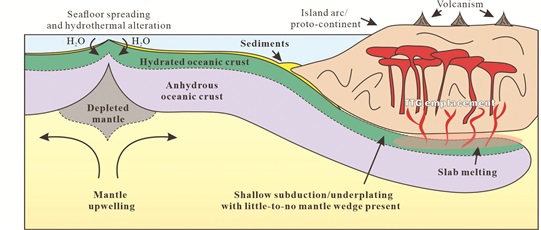
|
图 11 太古代TTG岩浆成因模式图(据Palin et al., 2016) Fig. 11 Schematic geodynamic settings for Archaean TTG magma genesis, subduction-related slab melting at a convergent plate boundary at shallow dip angle (after Palin et al., 2016) |
Ganade et al. (2017)认为巴西东北部Tróia地块存在两种类型的TTG岩石。一种没有显示任何地幔物质贡献的证据;另一种显示有地幔物质的贡献。他们认为前一种TTG是平俯冲洋壳部分熔融的产物,由于俯冲板片与上覆板片之间没有地幔楔存在,所生成的TTG熔体没有与地幔楔发生相互作用(图 12a)。随着俯冲洋壳的部分熔融、熔体释放和榴辉岩化,平俯冲的洋壳变重,导致其俯冲角度变陡,以及地幔楔的形成,上升的板片熔体与地幔楔橄榄岩相互作用形成了另一种显示有地幔物质贡献的TTG(图 12b)。
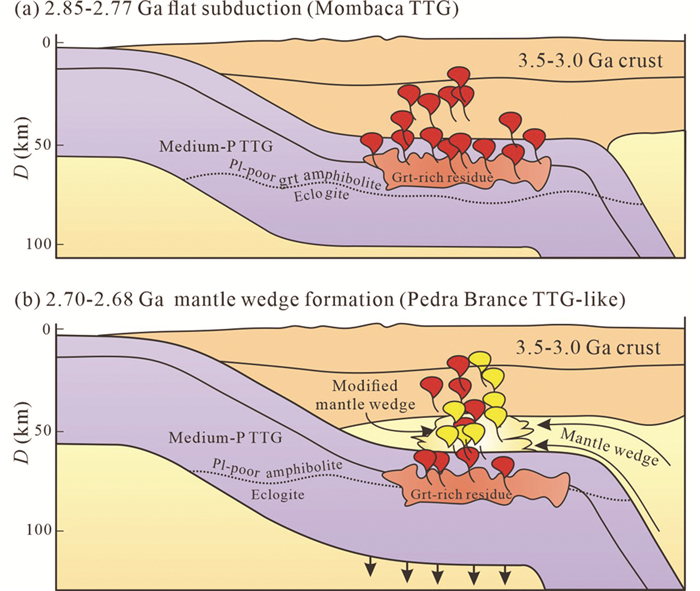
|
图 12 巴西东北部Tróia地块太古代TTG成因模式图(据Ganade et al., 2017) (a)洋壳平俯冲到大洋高原之下发生部分熔融形成TTG和富石榴石的残留体;(b)由于部分熔融和榴辉岩化,俯冲洋壳密度增加,俯冲角度变陡,地幔楔形成.起源于俯冲板片的TTG熔体与地幔楔相互作用 Fig. 12 Schematic geodynamic setting illustrating the origin of two types of TTG in Tróia Massif (after Ganade et al., 2017) |
许多研究认为,新生代埃达克岩是俯冲的年轻(< 5Ma)板片部分熔融的产物。但是,世界上已知的20个埃达克岩产地中仅有5个是产出在上新世至第四系扩张中心与海沟的三联点附近,在这些地方年轻的大洋岩石圈刚完成或正在俯冲。而其余的新生代埃达克岩与较老的(10~45Ma)岩石圈俯冲有关,这样的岩石圈在正常俯冲带的温度与压力条件下不会发生熔融。Gutscher et al. (2000)认为相对较老的大洋高原的平俯冲和部分熔融导致了这些埃达克岩的形成。研究表明,世界上已知的10个平板俯冲区有8个发育有现代或年轻的(< 6Ma)埃达克岩(图 13)。模拟和计算结果表明,与正常俯冲带板片表面具有较低的温度不同,当较老的板片平缓俯冲时,其P-T-t轨迹会在20kbar时变平,并在700℃和25kbar条件下与板片熔融区域交叉,由此发生部分熔融形成埃达克岩浆(图 14)。世界上有~10%的汇聚边缘正在发生大洋高原的平俯冲作用,那里可以出现导致相对较老的洋壳发生部分熔融所需要的温、压条件。基于对智利、厄瓜多尔和哥斯达黎加等平缓俯冲带的研究,Gutscher et al. (2000)提出大洋高原平俯冲带岩浆作用三个阶段模式(图 15):(1)早期的陡俯冲形成一个狭窄的在软流圈之上的钙碱性岩浆弧,距海沟~300km(图 15a);(2)大洋高原到达,平俯冲开始,俯冲板片在近于相同的深度前进几百千米,有相当长的平俯冲板片处在熔融条件下,因此,形成埃达克岩浆(图 15b, c);(3)平俯冲持续几百万年,软流圈楔消失,岩浆活动停止(图 15d),如在现代的智利中部和秘鲁。这一模型将热模拟与地球化学很好地结合在一起,为揭示弧岩浆作用和汇聚板块边缘的热演化提供了重要信息。
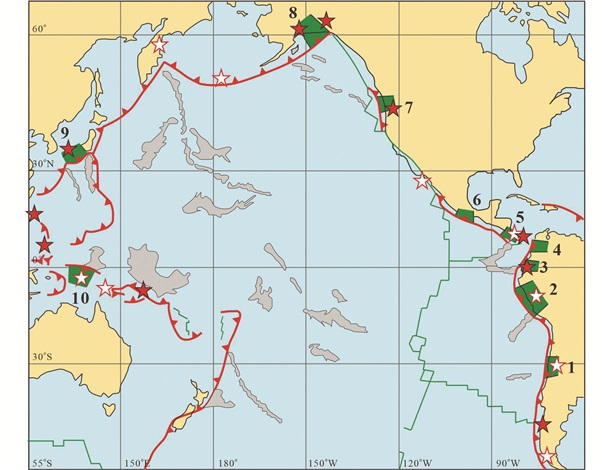
|
图 13 平板俯冲带与埃达克岩全球分布图(据Gutscher et al., 2000) 填充红色的星号为现代的埃达克岩产地,填充白色的星号为1~6Ma形成的埃达克岩.标数字的绿色区域为平板俯冲带,灰色区域为大洋高原和热点 Fig. 13 Global distribution of flat slab regions and adakitic magmas (after Gutscher et al., 2000) |

|
图 14 俯冲板片年龄和角度与俯冲板片表面P-T-t轨迹关系图(据Gutscher et al., 2000) (a)不同年龄的岩石圈以27°俯冲角俯冲的P-T-t轨迹(绿色实线)和在约70km深度以下平板俯冲的P-T-t轨迹(红色虚线).对于10~50Ma老的俯冲板片,其平俯冲后的P-T轨迹变平,并在700℃和25kbar条件下与板片熔融区域交叉;(b)陡(圆圈)和平(菱形和方形)俯冲板片表面的P-T-t轨迹.相应的P-T点是基于图 15中的地温梯度线,在陡(圆圈)和平(菱形和方形)俯冲板片表面每隔50km取一个点得出.图中的粉红色P-T域为与含角闪石(Hb)和石榴石(Grt)残留体共生的岩浆液体区域.Ec-榴辉岩;Am-角闪石岩 Fig. 14 Relationship diagrams among subducted slab age, angle and P-T-t path of surface of subducted slab (after Gutscher et al., 2000) |

|
图 15 大洋高原俯冲方式与弧岩浆作用模式图(据Gutscher et al., 2000) (a)陡俯冲或正常俯冲(俯冲角>30°),板片脱水和上覆软流圈地幔部分熔融形成狭窄的钙碱性岩浆弧,其距海沟~300km;(b)平俯冲早期的岩浆作用,俯冲洋壳在~80km深(距海沟300~400km)穿过700℃地温线,形成一个宽的埃达克质岩浆弧;(c)平俯冲晚期的岩浆作用,舌形软流圈冷却和后退,部分熔融发生在距离海沟更远(ca. 450~600km)的区域,为最后的岩浆脉冲期;(d)长期的无岩浆平俯冲期,俯冲的洋壳冷却到600℃以下,软流圈楔消失,没有部分熔融发生,火山作用停止 Fig. 15 Tectonic model of subduction styles of oceanic plateau and arc magmatism (after Gutscher et al., 2000) |
正像前面描述的,一般认为由TTG组成的太古代地壳是由类似MORB的玄武岩在热俯冲带环境下部分熔融形成的,即俯冲洋壳高压部分熔融形成了TTG和含石榴石的角闪岩或榴辉岩残留体。但是,地球化学模拟和玄武岩熔融实验均排除了MORB是TTG的源区,因为形成TTG需要一个LILE富集的、类似于大洋高原玄武岩的源区(Moyen and Stevens, 2006; Martin et al., 2014)。而且,地球上的俯冲作用是一个连续过程,而大陆地壳生长是幕式作用,几次超级地壳生长事件分别发生在~4.2Ga、~3.8Ga、~3.2Ga、~2.7Ga、~1.8Ga、~1.1Ga和~0.5Ga。为了解释地壳生长的幕式特征,有学者认为俯冲下沉的残余板片堆积在660km深的地震不连续面,当贮存的洋壳超过一个物质临界值时,就会像雪崩一样迅速沉进更深地幔,由此导致的地幔柱作用产生的大量岩浆形成了厚的大洋高原,大洋高原底部的熔融形成了TTG(Condie, 1998, 2005)。另外,Martin et al. (2014)提出TTG很可能是俯冲的大洋高原部分熔融形成的。大洋高原具有比周围洋壳更年轻的年龄,更大的厚度,不容易发生冷却,因此其具有更高的温度。大洋高原俯冲可以导致一个热俯冲带的形成,俯冲的洋壳可以发生部分熔融。而且,太古代的大洋高原比现代的高原更热、更厚(40~45km, Nair and Chacko, 2008),俯冲的高原洋壳更容易发生熔融。许多研究表明,在厄瓜多尔,由Galapagos热点活动形成的大洋高原(Carnegie脊)正在向南美板块之下俯冲。这不仅导致了埃达克质(类TTG)成分岩浆的形成,而且形成比安底斯弧其它地区更大体积的火山岩(Bourdon et al., 2002, 2003; Samaniego et al., 2002, 2005; Hidalgo et al., 2007)。Bourdon et al. (2003)提出年轻的(< 5Ma)、热的Carnegie脊(大洋高原)会发生平俯冲,这会使俯冲洋壳逐渐加热,进而发生部分熔融,形成埃达克岩。Martin et al. (2014)认为在整个地球历史中,大洋高原在某些时期发生的俯冲形成了巨量的TTG,由此导致了大陆地壳的幕式生长。
5 扩张洋中脊俯冲与板片部分熔融扩张洋中脊俯冲是板块构造的必然结果,在北美和南美板块西部正在经历扩张洋中脊的俯冲作用(图 16)。同时,在许多古老造山带也陆续发现了洋中脊俯冲的地质作用证据(Brown, 1998; Kinoshita, 2002; Windley et al., 2007; Sun et al., 2007; Yin et al., 2010; Tang et al., 2010; Zhang et al., 2010)。
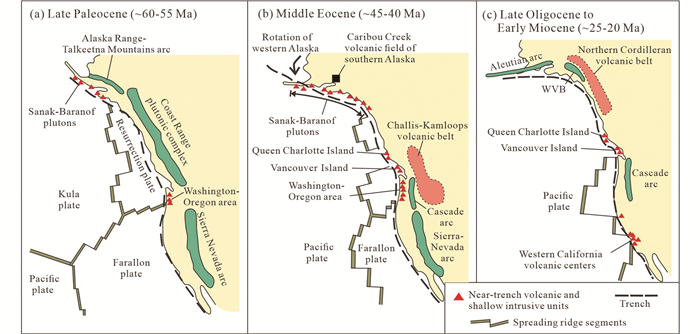
|
图 16 北美板块西缘新生代洋脊俯冲与近海沟火山岩和浅层侵入体分布再造图(据Cole and Stewart, 2009) (a)晚古新世,显示扩张脊-海沟交点在南阿拉斯加和西北太平洋(Washington造山带);(b)中中始新世,显示扩张脊-海沟交点在西北太平洋(加拿大西岸),这时Resurrection与Kula之间的扩张脊到达大陆边缘;(c)晚渐新世到早中新世,显示扩张脊-海沟交点在加里福尼亚西部.近海沟火山岩和浅层侵入体分布位置为扩张脊俯冲位置 Fig. 16 Tectonic reconstruction maps showing sites of Cenozoic spreading ridge-trench encounters and the generalized locations of near-trench, arc, and back arc igneous rocks along western North America (after Cole and Stewart, 2009) |
大量研究表明,在汇聚板块边缘,当洋中脊发生俯冲、扩张的洋中脊插入俯冲带时,会导致强烈的弧岩浆作用(Aguillón-Robles et al., 2001; Thorkelson and Breitsprecher, 2005; Cole and Stewart, 2009)。这是由于当扩张洋中脊发生俯冲时,大洋板片会在扩张脊处发生分离,形成板片窗,俯冲大洋板块的地幔就会直接与上覆板片接触(图 17; Dickinson and Snyder, 1979; Thorkelson and Taylor, 1989; Thorkelson, 1996; Cole and Stewart, 2009)。在这种情况下,俯冲洋壳之下(下板片)的地幔或软流圈会沿板片窗上涌,形成一个高热流环境,由此导致上覆的地壳岩石发生熔融形成中酸性岩浆(DeLong et al., 1979; Bradley et al., 2003),在板片窗边缘的洋壳发生部分熔融形成埃达克岩(Yogodzinski et al., 2001; Kinoshita, 2002; Thorkelson and Breitsprecher, 2005; Zhang et al., 2010),上覆基性地壳发生部分熔融形成埃达克质岩石(Cole et al., 2006),上涌的地幔发生降压熔融形成基性岩浆。除了岩浆作用强度发生明显变化外,扩张脊沿大陆边缘俯冲的其它标志还有高温变质作用(Sisson et al., 1989; Underwood et al., 1999; Iwamori, 2000)、板块运动学和变形的变化(Hibbard and Karig, 1990; Pavlis and Sisson, 1995; Lagabrielle et al., 2000; Ramos, 2005; Wilson et al., 2005)、增加的矿化作用(Haeussler et al., 1995)以及沉积盆地的变化(Graham et al., 1984; Flint et al., 1994; Dostal et al., 2001; Trop et al., 2003; Wilson et al., 2005)。所以,扩张洋脊俯冲和板片窗的形成被认为是活动大陆边缘岩浆、变质和构造作用变化的主要原因(Dickinson and Snyder, 1979; Johnson and O'Neil, 1984; Forsythe and Nelson, 1985; Thorkelson and Taylor, 1989; Sisson et al., 1994, 2003; Thorkelson, 1996)。

|
图 17 扩张脊俯冲、板片窗和大陆边缘岩浆作用模型(据Cole and Stewart, 2009) Fig. 17 Conceptual model for continental margin magmatism above a depleted mantle slab window following an episode of spreading ridge subduction (after Cole and Stewart, 2009) |
柯石英和金刚石在表壳岩石中的发现表明,大陆地壳可以被俯冲到>80km的地幔深度,然后又返回到地球表面。大陆深俯冲和超高压变质作用已经成为地球科学的前沿课题(Chopin, 2003; Zheng et al., 2011; Hermann and Rubatto, 2014)。深俯冲大陆地壳的部分熔融是俯冲带元素循环和地球化学分异的主要作用(Hermann and Rubatto, 2014)。
研究表明,相对大洋地壳,大陆地壳是较古老且具有较低的地温梯度和水含量。如果俯冲板片与地幔楔是耦合的,大陆俯冲带也是冷的(Li et al., 2011; Li, 2014)。岩石学和计算结果表明,与大洋岩石圈在俯冲过程中会不断发生脱水并可以将相当多的水带入到弧下深度完全不同,主要由花岗质片麻岩组成的大陆地壳具有很低的水含量,而且在其俯冲过程中,不论是冷的,还是热的俯冲带,都基本不会发生脱水反应(Hacker, 2008; 图 7)。这很可能是大陆俯冲带不发育同俯冲岩浆作用的根本原因。现有研究表明,俯冲大陆地壳的部分熔融主要是发生在高压-超高压变质岩折返过程中的脱水熔融,而很少有俯冲过程中部分熔融的证据(Prince et al., 2001; Liu et al., 2010, 2012; Ferrero et al., 2015; Deng et al., 2018)。
6.1 大陆地壳深俯冲过程中的部分熔融目前,在大陆碰撞带的超高压变质地体中还少有地壳岩石在俯冲过程中,即在进变质和峰期变质过程中发生部分熔融的报道。哈萨克斯坦的Kokchetav地块和中欧的Erzgebirge地块中产出的含金刚石的长英质岩石被认为是记录了在地幔深度超高压变质条件下的部分熔融作用。Massonne and Fockenberg (2012)进行了超高压条件下的实验研究和热力学计算,其结果表明,上述两个地区的含金刚石岩石在30kbar和50kbar下的固相线接近1000℃和1100℃。白云母脱水熔融形成的初始熔体具有钾质至超钾质的地球化学特征,相应的熔融反应是:多硅白云母+富钠单斜辉石+柯石英=熔体+石榴石+蓝晶石。在固相线之上~200℃,单斜辉石从残余矿物组合中消失,共生的熔体是花岗质的。由石榴石+柯石英±蓝晶石组成的残留体可稳定到接近液相线温度(固相线温之上~350℃)。基于该实验结果,研究者认为Erzgebirge地块中含金刚石长英质熔体的结晶温度高达1400℃,而Kokchetav地块的至少达到1200℃。有人认为这样的超高压和超高温变质与部分熔融发生在俯冲带,也有人认为是俯冲的沉积岩底辟到地幔楔中之后发生的部分熔融(Massonne and Fockenberg, 2012),因为数值模拟表明,这样的温度明显高于类似压力下俯冲板片表面的温度。Behn et al. (2011)认为深俯冲沉积岩在500~850℃温度下将从俯冲板片拆离,形成具有浮力的底辟体。底辟体上升经过热的地幔楔,当温度超过1000℃时发生了脱水熔融。
Stepanov et al. (2016)对哈萨克斯坦Kokchetav地块中含金刚石副片麻岩石榴石中的多相固体包体进行了高温高压实验研究。结果表明,多相包体可分两种类型,一种为产于中色体石榴石变斑晶中的M型包体,相应的熔体形成在950~1000℃和45~65kbar条件下,其以LREE、U和Th富集为特征,具有与青藏高原南部超钾质岩石类似的成分;第二种为产于浅色体石榴石中的L型包体,为晚期熔体,代表超高压变质岩在折返过程中,在地壳压力和650~750℃条件下形成的大规模熔体,其以低的LREE和Nb,高U为特征。这样的微量元素特征表明,超高压条件下产生的熔体具有与弧岩浆不同的地球化学组分。因此,他们认为超高压熔体没并参与像底辟模式建议的弧岩浆作用。相反,熔体包体高的LREE含量,LREE与HREE分异,富集LILE和钾质特征都与钾玄质岩浆类似。变质沉积岩在超高压条件下熔融产生的熔体与地幔橄榄岩相互作用可以产生具有不同主量元素成分的岩浆,但可以保持高的不相容元素含量。这样的作用可以形成在碰撞或后碰撞构造环境下常见的钾玄质岩浆(Campbell et al., 2014)。
大陆俯冲带的超高压变质岩是否发生部分熔融取决于它们的变质条件和P-T轨迹。如图 18所示,对于像大别-苏鲁和Kokchetav地块的超高压变质岩来说,其进变质和峰期变质P-T轨迹部分位于含水熔体区域,如果有水存在就会发生熔融。对于中性和长英质超高压变质岩来说,其最常见的矿物组合是多硅白云母、钾长石、柯石英、蓝晶石、石榴石和单斜辉石,多硅白云母是唯一的含水矿物。而多硅白云母在进变质到峰期过程中的稳定存在会阻碍岩石发生部分熔融。此外,对俯冲地壳中的大部分岩石来说水是不饱和的,在部分熔融发生之前,流体将通过形成含水相被消耗(如,钾长石+水=多硅白云母)。所以,进变质到峰期变质过程中,超高压岩石部分熔融仅可能发生在脱水反应可以提供水的特殊条件下。在富钙的中性岩中,黝帘石脱水发生在接近石英-柯石英相转变的P-T条件下(Poli and Schmidt, 2002),由此释放的流体有可能导致超高压变质作用早期发生熔融(Patiño Douce, 2005)。另外,绿泥石和滑石片岩脱水也可以提供流体(Fumagalli and Poli, 2005),会导致在俯冲地壳的局部存在富流体环境。总之,对于主要由长英质岩石组成的大陆地壳来说,其深俯冲过程中应该是缺少自由流体相的,不可能发生饱和水部分熔融,这是其与大洋俯冲带的重要差别。
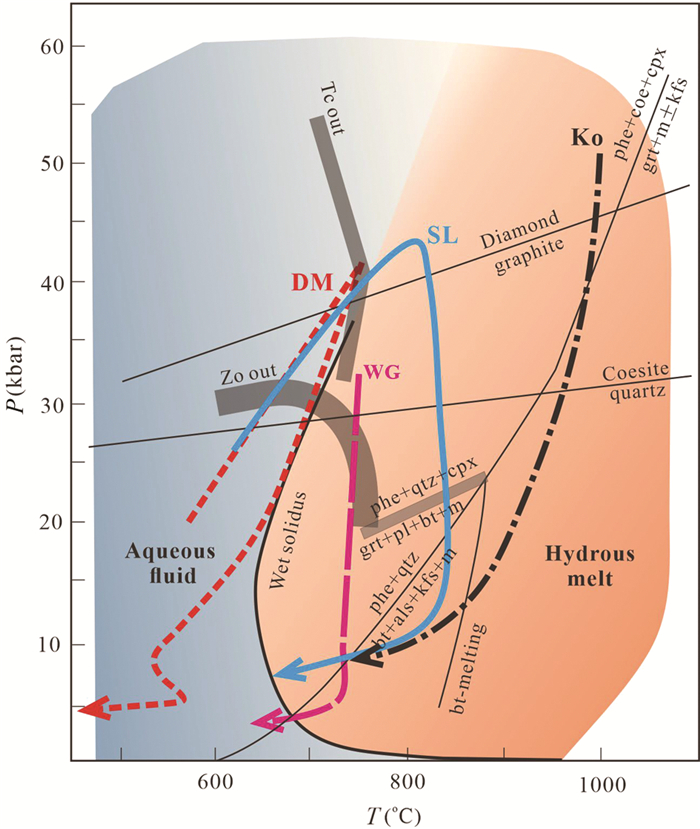
|
图 18 典型超高压变质岩的P-T轨迹与主要脱水熔融反应(据Hermann and Rubbatto, 2014修改) 图中显示,在中、高温超高压变质岩折返过程中可以发生与多硅白云母部分或全部分解相关的部分熔融. WG-Western Gneiss Region; DM-Dora Maira; Su-Sulu; Ko-Kokchetav Fig. 18 Metamorphic P-T paths of UHP rocks and major dehydration melting reactions (modified after Hermann and Rubbatto, 2014) |
越来越多的研究表明,在许多超高压变质地体中,超高压变质岩的部分熔融主要发生在其折返过程中,如,中国的大别-苏鲁造山带(Wallis et al., 2005; Zhao et al., 2007; Xia et al., 2008; Zeng et al., 2009; Liu et al., 2010, 2012, 2014; Gao et al., 2012a; Wang et al., 2014),中国柴北缘超高压变质带(Song et al., 2014, 2015; Zhang et al., 2015a),哈萨克斯坦Kokchetav地块(Hermann and Green, 2001; Dobretsov and Shatsky, 2004; Ragozin et al., 2009; Stepanov et al., 2014, 2016),挪威西部片麻岩区(Labrousse et al., 2011; Gordon et al., 2013)及其在格棱兰延伸部分(Lang and Gilotti, 2007),巴布亚新几内亚D'Entrecasteaux岛(Gordon et al., 2012)等。
尽管在中、高温超高压变质岩俯冲(从进变质到压力峰期)过程中发生部分熔融的可能性有限,但在其折返过程中,由于经历了近等温、或增温降压退变质作用,其P-T轨迹均处在水流体相区域,势必经历了与含水矿物脱水伴生的部分熔融(图 18)。如前文所述,多硅白云母为超高压地壳变质岩的主要含水矿物,与其相关的三个脱水熔融反应是:(1)多硅白云母+单斜辉石+柯石英=石榴石+熔体±蓝晶石±钾长石(Hermann and Green, 2001; Schmidt et al., 2004),在Erzgebirge和Kokchetav地块超高温和超高压变质岩降压过程中可以发生这样的脱水熔融反应。(2)多硅白云母+单斜辉石+柯石英=石榴石+黑云母+斜长石+熔体(Auzanneau et al., 2006)。由于这个反应具有很缓的斜率,在形成温度>750℃的超高压变质岩折返过程中都不可避免地通过这个反应发生熔融,所形成的石榴石具有较高的钙铝榴石组分,所以环带状石榴石的出现可以是降压过程中部分熔融的指示性标志(Auzanneau et al., 2006)。(3)多硅白云母+石英=蓝晶石+钾长石+熔体±黑云母(Vielzeuf and Holloway, 1988),这是超高压变质岩进一步降压发生的与多硅白云母分解相关的部分熔融反应。另外,如果降压发生在>800℃高温下,英云闪长质和杂砂质的岩石有可能发生黑云母脱水熔融(Patiño Douce, 2005; Vielzeuf and Holloway, 1988)。Auzanneau et al. (2006)的实验研究表明,超高压变质岩(变质杂砂岩)折返早期的熔融主要表现为无水矿物,如石榴石、石英/柯石英和单斜辉石的分解,因此可称之为降压熔融。
大别-苏鲁超高压变质带的研究表明,脱水熔融是超高压变质岩从地幔深度向上折返过程中发生熔融的主要机制(Lang and Gilotti, 2007; Xia et al., 2008; Zheng et al., 2011; Gao et al., 2012a, 2013, 2014; Chen et al., 2013a, b, 2014, 2017; Liu et al., 2013; Wang et al., 2014)。这种熔融可以通过含水矿物(如多硅白云母和黝帘石)的分解,即通过地壳岩石湿固相线上的各种转熔反应实现(Xia et al., 2008; Zheng et al., 2011; Liu et al., 2013)。超高压变质岩折返过程中易于发生脱水和降压熔融,很可能是深俯冲大陆地壳超高压变质作用特征难以保存的主要原因。
在高级变质和深熔岩石中,转熔矿物中的多相长英质包体,或称纳米花岗岩包体,为地壳岩石部分熔融提供了关键性证据(Cesare et al., 2009, 2015; Ferrero et al., 2012; Barich et al., 2014; Bartoli et al., 2013, 2014, 2016)。这样的包体多在几微米大小,主要由石英、长石和云母组成,或是玻璃质的,其全化学成分是花岗质的,因此常被认为是先前的熔体包体(Cesare et al., 2015; Bartoli et al., 2016)。目前在大别-苏鲁造山带基性和长英质的超高压变质岩中均发现了多相长英质包体,这些包体很可能是先前的含水熔体或不混熔的含水和碳酸盐质熔体(Zeng et al., 2009; Gao et al., 2012a, 2013, 2014, 2017a; Liu et al., 2013, 2014; Chen et al., 2014; Wang et al., 2014; Li et al., 2016)。值得注意的是,柯石英和金刚石可以出现在多相包体中,这表明部分熔融发生在超高压变质条件下(Hwang et al., 2001, 2006; Chen et al., 2013a, b; Stepanov et al., 2014, 2016)。
超高压变质岩在地幔中的深熔对汇聚板块边缘的地壳内部分异作用、构造热演化,以及壳-幔相互作用都具有重要意义(Wallis et al., 2005; Jamieson et al., 2011; Labrousse et al., 2011, 2015; Zheng et al., 2011; Zheng and Chen, 2016)。很明显,超高压峰变质条件下的部分熔融是具有地壳特征的含水熔体进入地幔的最有效作用。超高压变质岩发生低程度部分熔融后的残留体将比其原岩(上地壳岩石)更重,而比地幔要轻。这些岩石将在浮力作用下上升到壳-幔边界。超高压变质岩在大陆地壳底部的底侵被称之为“加层作用”(relamination; Hacker et al., 2011, 2015; Kelemen and Behn, 2016)。
6.3 大陆碰撞造山带加厚下地壳的部分熔融喜马拉雅造山带是印度和亚洲大陆在新生代碰撞作用的产物,是世界上最典型的碰撞造山带。喜马拉雅造山带核部由壮观的变质岩系和淡色花岗岩构成。这些淡色花岗岩是由印度大陆地壳组成的造山带加厚下地壳部分熔融的产物,是典型的S型花岗岩(Le Fort, 1975, 1981; Harris and Massey, 1994; Patiño Douce and Harris, 1998; Zeng et al., 2011, 2012; Guo and Wilson, 2012; 吴福元等, 2015; Gao et al., 2016, 2017b; Gou et al., 2016; Weinberg, 2016; 曾令森和高利娥, 2017; 张泽明等, 2018)。因此,喜马拉雅造山带是研究碰撞造山带地壳岩石部分熔融与花岗岩成因的天然实验室。本部分以此为例,总结碰撞造山带加厚下地壳的部分熔融作用。
在喜马拉雅造山带西段的Tso Morari(印度西北部)和Kaghan(巴基斯坦北部)地区,紧邻新特提斯洋缝合带产出有以含柯石英榴辉岩为代表的超高压变质岩(O'Brien et al., 2001; Sachan et al., 2004; St-Onge et al., 2013)。这些超高压变质岩具有~47Ma的峰期变质年龄和~40Ma的早期退变质年龄,是印度大陆西北缘快速陡俯冲到地幔深处经历超高压变质作用后又快速折返回来的地壳岩石(Guillot et al., 2008)。这些岩石具有相对低的峰期变质和退变质温度,在其俯冲和折返过程中没有或很少发生部分熔融。
在喜马拉雅造山带中-东段,大陆碰撞后,印度大陆平缓俯冲(underthrusting)到亚洲大陆之下,导致造山带地壳显著加厚,加厚下地壳经历了高压麻粒岩-榴辉岩相变质作用(图 3d; Lombardo and Rolfo, 2000; Groppo et al., 2007, 2012; Corrie et al., 2010; Kali et al., 2010; Guilmette et al., 2011; 刘凤林和张立飞, 2014; Regis et al., 2014; Sorcar et al., 2014; Iaccarino et al., 2015; Zhang et al., 2015b, 2017a, b; Tian et al., 2016, 2020; 田作林等, 2017; Wang et al., 2017a)。尽管现有研究所给出的变质条件有所不同,但是,所获得的P-T轨迹均为顺时针型,其进变质作用是以增温和增压为特征,早期退变质作用是以近等温或者弱升温减压为特征,晚期退变质作用为近等压降温过程(图 19)。

|
图 19 喜马拉雅造山带中-东段高压泥质麻粒岩变质作用P-T-t轨迹和脱水熔融与熔体结晶时间与持续过程(据张泽明等, 2018) Fig. 19 Metamorphic P-T-t path, and timing and duration of dehydration melting and melt crystallization of high-pressure pelitic granulites in the east-central Himalayan orogen (after Zhang et al., 2018) |
野外和岩石学观察表明,喜马拉雅造山带中-东段高喜马拉雅岩系中的各种岩石,包括基性、长英质和泥质变质岩都发生了部分熔融和混合岩化。但是,对高喜马拉雅岩系的熔融方式存在较大争议。较早期的研究多认为,高喜马拉雅岩系的部分熔融发生在减压退变质过程中,即近等温或升温过程中的减压导致了白云母和黑云母的脱水熔融(Pognante and Benna, 1993; Harris and Massey, 1994; Harris et al., 1995, 2004; Harrison et al., 1998; Patiño Douce and Harris, 1998; Searle, 1999; Zhang et al., 2004; Viskupic et al., 2005; King et al., 2011)。得出这一结论的主要理由是,岩石在最高压力下的变质温度低于含水矿物的脱水熔融温度,但在降压过程中,特别是在伴随有加热的降压过程中,岩石的P-T轨迹要穿过具有正斜率的矿物脱水熔融反应线,由此导致脱水熔融。但是,这在很大程度上是由于以前的研究高估了白云母和黑云母的脱水熔融温度,低估了岩石在最高压力下的变质温度。此外,由于淡色花岗岩多在高喜马拉雅岩系顶部沿藏南拆离系分布,从大多淡色花岗岩中获得的锆石结晶年龄与藏南拆离系的活动时间相似,所以,以前的研究多认为,藏南拆离系的活动导致了高喜马拉雅岩系的降压折返,诱发了其岩石的部分熔融(Cottle et al., 2009a, b)。
最近的研究表明,泥质和长英质变质岩石中白云母脱水熔融的温度在650~700℃(Rubatto et al., 2013; Wang et al., 2013, 2016, 2017b; Iaccarino et al., 2015; Zhang et al., 2015b),变基性岩中角闪石的脱水熔融温度类似或略高(Green et al., 2016; Palin et al., 2016; 田作林等, 2017; Kang et al., 2020)。尽管现有研究获得的高喜马拉雅岩系的变质温度有较大差别(720~900℃),但在最高压力下的变质温度都不同程度地超过了白云母脱水熔融温度(图 19),表明其在增温和增压的进变质过程中就可以发生部分熔融(Godin et al., 2001; Prince et al., 2001; Viskupic and Hodges, 2001; Zhang et al., 2004, 2015b, 2017a, b; Lee and Whitehouse, 2007; Cottle et al., 2009a; Streule et al., 2010; Guilmette et al., 2011; Imayama et al., 2012; Rubatto et al., 2013; 向华等, 2013; Finch et al., 2014; Regis et al., 2014)。Groppo et al.(2010, 2012)研究揭示,喜马拉雅造山带中段尼泊尔地区的长英质高压麻粒岩的部分熔融为白云母和黑云母脱水熔融,熔融主要发生在加热条件下,可以有也可以没有降压熔融的贡献。Rubatto et al. (2013)认为,锡金地区的泥质麻粒岩在进变质(增温)过程中先后发生了白云母和黑云母脱水熔融。Gou et al. (2016)和张泽明等(2017, 2018)认为,在印度大陆地壳俯冲过程中,变泥质和长英质岩石经历了增温和增压进变质作用,当变质温度达到~650℃,首先发生以白云母为主的脱水熔融,在进一步增压增温(达到峰压力)和降压增温(达到峰温度)过程中主要发生黑云母脱水熔融(图 19)。最近,在东喜马拉雅构造结长英质高压麻粒岩的转熔石榴石中发现了原生的微粒花岗岩(Nanogranite)包体(Carosi et al., 2015; Iaccarino et al., 2015)。这种多固相包体是石榴石生长过程中捕获的熔体包体,为高压麻粒岩进变质过程中发生部分熔融提供了重要的证据。此外,许多研究也表明高喜马拉雅岩系的部分熔融主要发生在高压变质条件下。许多泥质和长英质混合岩的浅色体中含高压矿物蓝晶石,为加厚下地壳发生部分熔融提供了确切证据(Carosi et al., 2015; Iaccarino et al., 2015)。而且,基于地球化学研究,喜马拉雅造山带北部的始新世埃达克质(高Sr/Y比)花岗岩被认为是造山带加厚下地壳基性岩部分熔融的产物(Zeng et al., 2011; Hou et al., 2012),进一步证实加厚下地壳发生了部分熔融。
大量研究表明,高喜马拉雅岩系经历了~20Myr的持续高温变质与部分熔融过程(Cottle et al., 2009a; Kellett et al., 2013; Rubatto et al., 2013; Wang et al., 2013, 2016; Carosi et al., 2015; Iaccarino et al., 2015; Zhang et al., 2015b, 2017a, b)。基于现有研究成果,张泽明等(2017, 2018)认为高喜马拉雅岩系的高温变质和部分熔融很可能在~45Ma就已经开始,并持续到~25Ma的峰期,之后是近等温降压退变质和持续的部分熔融。在ca.15~7Ma,岩石经历了近等压降温退变质和熔体结晶过程(图 19)。
尽管喜马拉雅淡色花岗岩经常获得早-中中新世的锆石结晶年龄(Guo and Wilson, 2012; 吴福元等, 2015),但也获得了许多35~25Ma的锆石结晶年龄(Godin et al., 2001; Prince et al., 2001; Viskupic and Hodges, 2001; Zhang et al., 2004; Lee and Whitehouse, 2007; Cottle et al, 2009a; Groppo et al., 2010; Imayama et al., 2012; Rubatto et al., 2013; Liu et al., 2016),甚至中始新世的锆石结晶年龄(Aikman et al., 2008, 2012; 戚学祥等, 2008; Zeng et al., 2011; Gao et al., 2012b; Hou et al., 2012)。这充分说明,高喜马拉雅岩系的部分熔融在其折返开始之前(~25Ma)就已经发生,并不像以往认为的高喜马拉雅岩系在折返过程中的明显降压导致了部分熔融。事实上,对单个淡色花岗岩样品中的锆石和独居石进行定年,常常会获得很大的年龄范围,或几组不同的年龄(Cottle et al., 2007, 2009b; Lee and Whitehouse, 2007; Langille et al., 2012; Zeng et al., 2012; Zhang et al., 2012; Lederer et al., 2013)。对此有两种不同的解释,一种是认为这些可变的年龄表明岩浆是通过多阶段部分熔融形成的,另一种是认为岩浆经历了长时间持续结晶过程。值得注意的是,从具有岩浆结晶特征的锆石和独居石中获得的年龄仅代表它们的结晶年龄。这个年龄可以等于或老于岩体的最后就位时间,但很可能晚于源区部分熔融的时间。在高喜马拉雅岩系长期的熔融过程中,如果所形成的熔体分批次抽离,并快速上升就位,就会形成不同时代的淡色花岗岩,岩石中的锆石或独居石会给出较一致的结晶年龄。如果所形成的熔体较长时间保留在源区,或慢速上升,所形成的淡色花岗岩中的锆石或独居石会获得不同的结晶年龄。正如上文描述的,变质岩石学和岩石年代学研究结果表明,高喜马拉雅岩系经历了长期持续的部分熔融过程(45~15Ma),这使形成具有不同锆石或独居石结晶年龄的淡色花岗岩成为可能。
7 主要认识(1) 俯冲带的热结构俯冲带是岩石圈不对称沉入地幔的三维区域,由于俯冲的岩石圈具有较低的温度,所以俯冲带相对于周围的地幔是冷的。板片的年龄、厚度、宽度、俯冲速率、俯冲角度以及俯冲板片与地幔的耦合程度是控制俯冲带热结构的重要因素。总的来说,大陆俯冲带是冷体制,而大洋俯冲带可以是冷体制,也可以是热体制。大洋岩石圈俯冲带包括两个端元类型,一个是智利(Chilean)型,为年轻的、薄的、热的和轻的大洋岩石圈发生低角度缓慢俯冲,俯冲板片表面具有较高的温度,是暖俯冲带;另一种类型是马里亚纳(Mariana)型,为老的、厚的、冷的和重的大洋岩石圈发生高角度快速俯冲,俯冲板片表面具有低的温度,是冷俯冲带。
(2) 俯冲带的含水性在大洋岩石圈俯冲过程中,水化的洋壳和下覆地幔中的含水矿物会随温度与压力的增加逐渐发生脱水,导致俯冲板片,特别是地幔楔发生部分熔融。在冷俯冲带,俯冲的大洋板片也会将一部分水通过新形成的超高压含水矿物或以名义上无水矿物中的结构水形式带入到更深地幔。主要由花岗质片麻岩组成的大陆地壳具有很低的水含量,而且在其俯冲过程中很少发生脱水作用,所以大陆岩石圈俯冲带相对较干,只能将少量水带入地幔。这也许正是大陆俯冲带岩浆作用不发育的主要原因。
(3) 正常大洋岩石圈俯冲带的部分熔融在正常俯冲带的弧下深度,俯冲大洋板片的表面温度会达到某些含水矿物的脱水条件,并超过水饱和的长英质或基性岩的固相线。因此,俯冲的大洋板片可以发生部分熔融,如蚀变的基性岩脱水导致俯冲的变质沉积岩发生部分熔融,蚀变的超基性岩脱水导致俯冲的洋壳发生熔融。起源于变质沉积岩的熔体是将俯冲板片组分迁移进地幔楔弧岩浆源区的最有效方式。
(4) 大洋岩石圈热俯冲带的部分熔融当年轻的、薄的、热的和轻的大洋岩石圈发生低角度缓慢俯冲时,俯冲板片表面具有较高的温度,在弧下深部可以发生饱和水或脱水熔融,形成埃达克质岩浆岩。太古代的俯冲带很可能具有与年轻洋壳俯冲带类似的热结构,俯冲的洋壳板片部分熔融可以形成与埃达克岩成分类似的TTG。俯冲大洋板片的部分熔融很可能是形成大陆地壳的直接方式之一。
(5) 大洋高原平俯冲带的部分熔融大洋高原相对于周围的洋壳具有更大的厚度、更小的年龄和更高的温度,这使得大洋高原易发生平俯冲作用,并形成热的俯冲带。因此,俯冲大洋高原的基性岩可以发生部分熔融产生埃达克岩。环太平洋俯冲带分布的许多埃达克岩是平俯冲大洋高原(或洋脊)的部分熔融产物。在整个地球历史中,某些特定时期发生的大洋高原俯冲和部分熔融可以解释大陆地壳生长的幕式特征。
(6) 扩张洋中脊俯冲与板片部分熔融扩张洋中脊俯冲是大洋岩石圈俯冲消亡的必然结果。在汇聚板块边缘,当扩张洋中脊插入俯冲带时会形成一个板片窗,俯冲洋壳之下的地幔或软流圈沿板片窗上涌形成一个高热流环境,由此导致板片窗边缘的洋壳和上覆的基性地壳发生部分熔融形成埃达克岩,上涌的地幔发生降压熔融形成基性岩浆岩。
(7) 大陆俯冲带的部分熔融大陆地壳具有很低的含水量,在其深俯冲过程中很难发生部分熔融。哈萨克斯坦Kokchetav和中欧Erzgebirge地块中的含金刚石长英质岩石被认为是在超高压和超高压温条件下白云母脱水熔融的产物。有人认为这样的部分熔融发生在俯冲带,但也有人认为是俯冲的沉积岩底辟到地幔楔中后发生的。超高压变质岩在地幔深部熔融形成的熔体与地幔发生相互作用是形成碰撞后钾质至超钾质火山岩的可能机制。
与大陆地壳深俯冲过程中难以发生部分熔融相反,在中-高温、超高压变质岩折返过程中,由于经历了近等温、或增温降压退变质作用,会发生广泛的部分熔融。超高压变质岩部分熔融后的残留体比原岩更重,比地幔要轻,将在浮力作用下加层(relamination)到大陆地壳底部。这可能是大陆地壳生长与再造的重要途径。
(8) 大陆碰撞带的部分熔融在世界上最典型的碰撞造山带——喜马拉雅造山带的中-东段,大陆碰撞后印度大陆地壳平缓俯冲到亚洲大陆之下,构成造山带的加厚下地壳,并经历高压麻粒岩-榴辉岩相变质作用。高温、高压变质的泥质、长英质和基性岩在进变质过程中经历了持续的饱和水熔融和脱水熔融,形成了典型的S型花岗岩和埃达克质花岗岩。
致谢 本文的部分内容曾在郑永飞院士组织的“板块俯冲带”研讨会上交流。感谢张建新研究员和宋述光教授审阅全文,并提出了重要修改意见。
Aguillón-Robles A, Calmus T, Benoit M, Bellon H, Maury RC, Cotten J, Bourgois J and Michaud F. 2001. Late Miocene adakites and Nb-enriched basalts from Vizcaino Peninsula, Mexico:Indicators of East Pacific Rise subduction below southern Baja California?. Geology, 29(6): 531-534 DOI:10.1130/0091-7613(2001)029<0531:LMAANE>2.0.CO;2 |
Aikman AB, Harrison TM and Lin D. 2008. Evidence for early (>44Ma) Himalayan crustal thickening, Tethyan Himalaya, Southeastern Tibet. Earth and Planetary Science Letters, 274(1-2): 14-23 DOI:10.1016/j.epsl.2008.06.038 |
Aikman AB, Harrison TM and Hermann J. 2012. The origin of Eo-and Neo-Himalayan granitoids, Eastern Tibet. Journal of Asian Earth Sciences, 58: 143-157 DOI:10.1016/j.jseaes.2012.05.018 |
Angiboust S, Hyppolito T, Glodny J, Cambeses A, Garcia-Casco A, Calderón M and Juliani C. 2017. Hot subduction in the middle Jurassic and partial melting of oceanic crust in Chilean Patagonia. Gondwana Research, 42: 104-125 DOI:10.1016/j.gr.2016.10.007 |
Auzanneau E, Vielzeuf D and Schmidt MW. 2006. Experimental evidence of decompression melting during exhumation of subducted continental crust. Contributions to Mineralogy and Petrology, 152(2): 125-148 DOI:10.1007/s00410-006-0104-5 |
Barich A, Acosta-Vigil A, Garrido CJ, Cesare B, Tajčmanová L and Bartoli O. 2014. Microstructures and petrology of melt inclusions in the anatectic sequence of Jubrique (Betic Cordillera, S Spain):Implications for crustal anatexis. Lithos, 206-207: 303-320 DOI:10.1016/j.lithos.2014.08.003 |
Bartoli O, Cesare B, Poli S, Bodnar RJ, Acosta-Vigil A, Frezzotti ML and Meli S. 2013. Recovering the composition of melt and the fluid regime at the onset of crustal anatexis and S-type granite formation. Geology, 41(2): 115-118 |
Bartoli O, Cesare B, Remusat L, Acosta-Vigil A and Poli S. 2014. The H2O content of granite embryos. Earth and Planetary Science Letters, 395: 281-290 DOI:10.1016/j.epsl.2014.03.031 |
Bartoli O, Acosta-Vigil A, Ferrero S and Cesare B. 2016. Granitoid magmas preserved as melt inclusions in high-grade metamorphic rock. American Mineralogist, 101(7): 1543-1559 DOI:10.2138/am-2016-5541CCBYNCND |
Beard JS and Lofgren GE. 1991. Dehydration melting and water-saturated melting of basaltic and andesitic greenstones and amphibolites at 1, 3, and 6.9kb. Journal of Petrology, 32(2): 365-401 DOI:10.1093/petrology/32.2.365 |
Behn MD, Kelemen PB, Hirth G, Hacker BR and Massonne HJ. 2011. Diapirs as the source of the sediment signature in arc lavas. Nature Geoscience, 4: 641-646 DOI:10.1038/ngeo1214 |
Bouilhol P, Magni V, Van Hunen J and Kaislaniemi L. 2015. A numerical approach to melting in warm subduction zones. Earth and Planetary Science Letters, 411: 37-44 DOI:10.1016/j.epsl.2014.11.043 |
Bourdon E, Eissen JP, Monzier M, Robin C, Martin H, Cotten J and Hall ML. 2002. Adakite-like lavas from Antisana volcano (Ecuador):Evidence for slab melt metasomatism beneath Andean Northern Volcanic Zone. Journal of Petrology, 43(2): 199-217 DOI:10.1093/petrology/43.2.199 |
Bourdon E, Eissen JP, Gutscher MA, Monzier M, Hall ML and Cotten J. 2003. Magmatic response to early aseismic ridge subduction:The Ecuadorian margin case (South America). Earth and Planetary Science Letters, 205(3-4): 123-138 DOI:10.1016/S0012-821X(02)01024-5 |
Bradley DC, Kusky TM, Haeussler PJ, Goldfarb RJ, Miller ML, Dumoulin JA, Nelson SW and Karl SM. 2003. Geologic signature of Early Tertiary ridge subduction in Alaska. In:Sisson VB, Roeske SM and Pavlis TL (eds.). Geology of a Transpressional Orogen Developed During Ridge-Trench Interaction along the North Pacific Margin. Geological Society of America, Special Paper, 371:19-49
|
Brown M. 1998. Ridge-trench interactions and high-T-low-P metamorphism, with particular reference to the Cretaceous evolution of the Japanese Islands. The Geological Society, London, Special Publications, 138(1): 137-169 DOI:10.1144/GSL.SP.1996.138.01.09 |
Campbell IH, Stepanov AS, Liang HY, Allen CM, Norman MD, Zhang YQ and Xie YW. 2014. The origin of shoshonites:New insights from the Tertiary high-potassium intrusions of eastern Tibet. Contributions to Mineralogy and Petrology, 167(3): 1-22 |
Carosi R, Montomoli C, Langone A, Turina A, Cesare B, Iaccarino S, Fascioli L, Visonà D, Ronchi A and Rai SM. 2015. Eocene partial melting recorded in peritectic garnets from kyanite-gneiss, Greater Himalayan Sequence, central Nepal. The Geological Society, London, Special Publications, 412: 111-129 DOI:10.1144/SP412.1 |
Cesare B, Ferrero S, Salvioli-Mariani E, Pedron D and Cavallo A. 2009. "Nanogranite" and glassy inclusions:The anatectic melt in migmatites and granulites. Geology, 37(7): 627-630 DOI:10.1130/G25759A.1 |
Cesare B, Acosta-Vigil A, Bartoli O and Ferrero S. 2015. What can we learn from melt inclusions in migmatites and granulites?. Lithos, 239: 186-216 DOI:10.1016/j.lithos.2015.09.028 |
Chen YX, Zheng YF and Hu ZC. 2013a. Synexhumation anatexis of ultrahigh-pressure metamorphic rocks:Petrological evidence from granitic gneiss in the Sulu orogen. Lithos, 156-159: 69-96 DOI:10.1016/j.lithos.2012.10.008 |
Chen YX, Zheng YF and Hu Z. 2013b. Petrological and zircon evidence for anatexis of UHP quartzite during continental collision in the Sulu orogen. Journal of Metamorphic Geology, 31(4): 389-413 DOI:10.1111/jmg.12026 |
Chen YX, Zheng YF, Gao XY and Hu ZC. 2014. Multiphase solid inclusions in zoisite-bearing eclogite:Evidence for partial melting of ultrahigh-pressure metamorphic rocks during continental collision. Lithos, 200-201: 1-21 DOI:10.1016/j.lithos.2014.04.004 |
Chen YX, Zhou K and Gao XY. 2017. Partial melting of ultrahigh-pressure metamorphic rocks during continental collision:Evidence, time, mechanism, and effect. Journal of Asian Earth Sciences, 145: 177-191 DOI:10.1016/j.jseaes.2017.03.020 |
Chopin C. 2003. Ultrahigh-pressure metamorphism:Tracing continental crust into the mantle. Earth and Planetary Science Letters, 212(1-2): 1-14 DOI:10.1016/S0012-821X(03)00261-9 |
Cole RB, Nelson SW, Layer PW and Oswald PJ. 2006. Eocene volcanism above a depleted mantle slab window in Southern Alaska. GSA Bulletin, 118(1-2): 140-158 DOI:10.1130/B25658.1 |
Cole RB and Stewart BW. 2009. Continental margin volcanism at sites of spreading ridge subduction:Examples from southern Alaska and western California. Tectonophysics, 464(1-4): 118-136 DOI:10.1016/j.tecto.2007.12.005 |
Condie KC. 1998. Episodic continental growth and supercontinents:A mantle avalanche connection?. Earth and Planetary Science Letters, 163(1-4): 97-108 DOI:10.1016/S0012-821X(98)00178-2 |
Condie KC. 2005. TTGs and adakites:Are they both slab melts?. Lithos, 80(1-4): 33-44 DOI:10.1016/j.lithos.2003.11.001 |
Cooper LB, Ruscitto DM, Plank T, Wallace PJ, Syracuse EM and Manning CE. 2012. Global variations in H2O/Ce:1. Slab surface temperatures beneath volcanic arcs. Geochemistry, Geophysics, Geosystems, 13(3): Q03024 |
Corrie SL, Kohn MJ and Vervoort JD. 2010. Young eclogite from the Greater Himalayan Sequence, Arun Valley, Eastern Nepal:P-T-t path and tectonic implications. Earth and Planetary Science Letters, 289(3-4): 406-416 DOI:10.1016/j.epsl.2009.11.029 |
Cottle JM, Jessup MJ, Newell DL, Searle MP, Law RD and Horstwood MSA. 2007. Structural insights into the early stages of exhumation along an orogen-scale detachment:The South Tibetan Detachment System, Dzakaa Chu section, eastern Himalaya. Journal of Structural Geology, 29(11): 1781-1797 DOI:10.1016/j.jsg.2007.08.007 |
Cottle JM, Jessup MJ, Newell DL, Horstwood MSA, Noble SR, Parrish RR, Waters DJ and Searle MP. 2009a. Geochronology of granulitized eclogite from the Ama Drime Massif:Implications for the tectonic evolution of the South Tibetan Himalaya. Tectonics, 28(1): TC1002 DOI:10.1029/2008TC002256 |
Cottle JM, Searle MP, Horstwood MSA and Waters DJ. 2009b. Timing of midcrustal metamorphism, melting, and deformation in the Mount Everest region of Southern Tibet revealed by U(-Th)-Pb geochronology. The Journal of Geology, 117(6): 643-664 DOI:10.1086/605994 |
Davies JH and Stevenson DJ. 1992. Physical model of source region of subduction zone volcanics. Journal of Geophysics Research:Solid Earth, 97(B2): 2037-2070 DOI:10.1029/91JB02571 |
Defant MJ and Drummond MS. 1990. Derivation of some modern arc magmas by melting of young subducted lithosphere. Nature, 347(6294): 662-665 DOI:10.1038/347662a0 |
DeLong SE, Schwarz WM and Anderson RN. 1979. Thermal effects of ridge subduction. Earth and Planetary Science Letters, 44(2): 239-246 DOI:10.1016/0012-821X(79)90172-9 |
Deng LP, Liu YC, Gu XF, Groppo C and Rolfo F. 2018. Partial melting of ultrahigh-pressure metamorphic rocks at convergent continental margins:Evidences, melt compositions and physical effects. Geoscience Frontiers, 9(4): 1229-1242 DOI:10.1016/j.gsf.2017.08.002 |
Dickinson WR and Snyder WS. 1979. Geometry of triple junctions related to San Andreas transform. Journal of Geophysics Research:Solid Earth, 84(B2): 561-572 DOI:10.1029/JB084iB02p00561 |
Dixon JE and Stolper EM. 1995. An experimental study of water and carbon dioxide solubilities in mid-ocean ridge basaltic liquids. Part Ⅱ:Applications to degassing. Journal of Petrology, 36(6): 1633-1646 |
Dixon JE, Stolper EM and Holloway JR. 1995. Stolper EM and Holloway JR. 1995. An experimental study of water and carbon dioxide solubilities in mid-ocean ridge basaltic liquids. Part Ⅰ:Calibration and solubility models. Journal of Petrology, 36(6): 1607-1631 |
Dobretsov NL and Shatsky VS. 2004. Exhumation of high-pressure rocks of the Kokchetav massif:Facts and models. Lithos, 78(3): 307-318 DOI:10.1016/j.lithos.2004.05.003 |
Dostal J, Church BN, Reynolds PH and Hopkinson L. 2001. Eocene volcanism in the Buck Creek basin, central British Columbia (Canada):Transition from arc to extensional volcanism. Journal of Volcanology and Geothermal Research, 107(1-3): 149-170 DOI:10.1016/S0377-0273(00)00261-4 |
Drummond MS and Defant MJ. 1990. A model for trondhjemite-tonalite-dacite genesis and crustal growth via slab melting:Archean to modern comparisons. Journal of Geophysics Research:Solid Earth, 95(B13): 21503-21521 DOI:10.1029/JB095iB13p21503 |
Duggen S, Portnyagin M, Baker J, Ulfbeck D, Hoernle K, Garbe-Schönberg D and Grassineau N. 2007. Drastic shift in lava geochemistry in the volcanic-front to rear-arc region of the Southern Kamchatkan subduction zone:Evidence for the transition from slab surface dehydration to sediment melting. Geochimica et Cosmochimica Acta, 71(2): 452-480 DOI:10.1016/j.gca.2006.09.018 |
Ferrero S, Bartoli O, Cesare B, Salvioli-Mariani E, Acosta-Vigil A, Cavallo A, Groppo C and Battiston S. 2012. Microstructures of melt inclusions in anatectic metasedimentary rocks. Journal of Metamorphic Geology, 30(3): 303-322 DOI:10.1111/j.1525-1314.2011.00968.x |
Ferrero S, Wunder B, Walczak K, O'Brien PJ and Ziemann MA. 2015. Preserved near ultrahigh-pressure melt from continental crust subducted to mantle depths. Geology, 43(5): 447-450 DOI:10.1130/G36534.1 |
Finch M, Hasalová P, Weinberg RF and Fanning CM. 2014. Switch from thrusting to normal shearing in the Zanskar shear zone, NW Himalaya:Implications for channel flow. GSA Bulletin, 126(7-8): 892-924 DOI:10.1130/B30817.1 |
Fischer R and Gerya T. 2016. Early Earth plume-lid tectonics:A high-resolution 3D numerical modelling approach. Journal of Geodynamics, 100: 198-214 DOI:10.1016/j.jog.2016.03.004 |
Flint SS, Prior DJ, Agar SM and Turner P. 1994. Stratigraphic and structural evolution of the Tertiary Cosmelli Basin and its relationship to the Chile triple junction. Journal of the Geological Society, 151(2): 251-268 DOI:10.1144/gsjgs.151.2.0251 |
Foley S, Tiepolo M and Vannucci R. 2002. Growth of early continental crust controlled by melting of amphibolite in subduction zones. Nature, 417(6891): 837-840 DOI:10.1038/nature00799 |
Forsythe R and Nelson E. 1985. Geological manifestations of ridge collision:Evidence from the Golfo de Penas-Taitao basin, southern Chile. Tectonics, 4(5): 477-495 DOI:10.1029/TC004i005p00477 |
Frisch W, Meschede M and Blakey RC. 2011. Plate Tectonics: Continental Drift and Mountain Building. Berlin Heidelberg: Springer-Verlag
|
Fumagalli P and Poli S. 2005. Experimentally determined phase relations in hydrous peridotites to 6.5GPa and their consequences on the dynamics of subduction zones. Journal of Petrology, 46(3): 555-578 |
Ganade CE, Basei MAS, Grandjean FC, Armstrong R and Brito RS. 2017. Contrasting Archaean (2.85~2.68Ga) TTGs from the Troia Massif (NE-Brazil) and their geodynamic implications for flat to steep subduction transition. Precambrian Research, 297: 1-18 DOI:10.1016/j.precamres.2017.05.007 |
Gao LE, Zeng LS and Xie KJ. 2012b. Eocene high grade metamorphism and crustal anatexis in the North Himalaya Gneiss Domes, Southern Tibet. Chinese Science Bulletin, 57(6): 639-650 DOI:10.1007/s11434-011-4805-4 |
Gao LE, Zeng LS, Gao JH, Shang Z, Hou KJ and Wang Q. 2016. Oligocene crustal anatexis in the Tethyan Himalaya, southern Tibet. Lithos, 264: 201-209 DOI:10.1016/j.lithos.2016.08.038 |
Gao LE, Zeng LS and Asimow PD. 2017b. Contrasting geochemical signatures of fluid-absent versus fluid-fluxed melting of muscovite in metasedimentary sources:The Himalayan leucogranites. Geology, 45(1): 39-42 |
Gao XY, Zheng YF and Chen YX. 2012a. Dehydration melting of ultrahigh-pressure eclogite in the Dabie orogen:Evidence from multiphase solid inclusions in garnet. Journal of Metamorphic Geology, 30(2): 193-212 DOI:10.1111/j.1525-1314.2011.00962.x |
Gao XY, Zheng YF, Chen YX and Hu Z. 2013. Trace element composition of continentally subducted slab-derived melt:Insight from multiphase solid inclusions in ultrahigh-pressure eclogite in the Dabie orogen. Journal of Metamorphic Geology, 31(4): 453-468 DOI:10.1111/jmg.12029 |
Gao XY, Zheng YF, Chen YX and Hu Z. 2014. Composite carbonate and silicate multiphase solid inclusions in metamorphic garnet from ultrahigh-P eclogite in the Dabie orogen. Journal of Metamorphic Geology, 32(9): 961-980 DOI:10.1111/jmg.12102 |
Gao XY, Chen YX and Zhang QQ. 2017a. Multiphase solid inclusions in ultrahigh-pressure metamorphic rocks:A snapshot of anatectic melts during continental collision. Journal of Asian Earth Sciences, 145: 192-204 DOI:10.1016/j.jseaes.2017.03.036 |
García-Casco A, Lázaro C, Rojas-Agramonte Y, Kröner A, Torres-Roldan RL, Núñez K, Neubauer F, Millán G and Blanco-Quintero I. 2008. Partial melting and counterclockwise P-T path of subducted oceanic crust (Sierra del Convento mélange, Cuba). Journal of Petrology, 49(1): 129-161 |
George R, Turner S, Morris J, Plank T, Hawkesworth C and Ryan J. 2005. Pressure-temperature-time paths of sediment recycling beneath the Tonga-Kermadec arc. Earth and Planetary Science Letters, 233(1-2): 195-211 DOI:10.1016/j.epsl.2005.01.020 |
Gerya TV, Stöckhert B and Perchuk AL. 2002. Exhumation of high-pressure metamorphic rocks in a subduction channel:A numerical simulation. Tectonics, 21(6): 6-1 |
Gill JB. 1974. Role of underthrust oceanic crust in the genesis of a Fijian calc-alkaline suite. Contributions to Mineralogy and Petrology, 43(1): 29-45 DOI:10.1007/BF00384650 |
Gill JB. 1978. Role of trace element partition coefficients in models of andesite genesis. Geochimica et Cosmochimica Acta, 42(6): 709-724 DOI:10.1016/0016-7037(78)90089-3 |
Godin L, Parrish RR, Brown RL and Hodges KV. 2001. Crustal thickening leading to exhumation of the Himalayan metamorphic core of Central Nepal:Insight from U-Pb geochronology and 40Ar/39Ar thermochronology. Tectonics, 20(5): 729-747 DOI:10.1029/2000TC001204 |
Gordon SM, Little TA, Hacker BR, Bowring SA, Korchinski M, Baldwin SL and Kylander-Clark ARC. 2012. Multi-stage exhumation of young UHP-HP rocks:Timescales of melt crystallization in the D'Entrecasteaux Islands, southeastern Papua New Guinea. Earth and Planetary Science Letters, 351-352: 237-246 DOI:10.1016/j.epsl.2012.07.014 |
Gordon SM, Whitney DL, Teyssier C and Fossen H. 2013. U-Pb dates and trace-element geochemistry of zircon from migmatite, Western Gneiss Region, Norway:Significance for history of partial melting in continental subduction. Lithos, 170-171: 35-53 DOI:10.1016/j.lithos.2013.02.003 |
Gou ZB, Zhang ZM, Dong X, Xiang H, Ding HX, Tian ZL and Lei HC. 2016. Petrogenesis and tectonic implications of the Yadong leucogranites, southern Himalaya. Lithos, 256-257: 300-310 DOI:10.1016/j.lithos.2016.04.009 |
Graham SA, McCloy C, Hitzman M, Ward R and Turner R. 1984. Basin evolution during change from convergent to transform continental margin in central California. AAPG Bulletin, 68(3): 233-249 |
Green DH. 1982. Anatexis of mafic crust and high pressure crystallization of andesite. In: Thorpe RS (ed.). Andesites: Orogenic Andesites and Related Rocks. New York: Wiley, 465-487
|
Green ECR, White RW, Diener JFA, Powell R, Holland TJB and Palin RM. 2016. Activity-composition relations for the calculation of partial melting equilibria in metabasic rocks. Journal of Metamorphic Geology, 34(9): 845-869 DOI:10.1111/jmg.12211 |
Groppo C, Lombardo B, Rolfo F and Pertusati P. 2007. Clockwise exhumation path of granulitized eclogites from the Ama Drime range (Eastern Himalayas). Journal of Metamorphic Geology, 25(1): 51-75 DOI:10.1111/j.1525-1314.2006.00678.x |
Groppo C, Rubatto D, Rolfo F and Lombardo B. 2010. Early Oligocene partial melting in the main Central thrust zone (Arun Valley, eastern Nepal Himalaya). Lithos, 118(3-4): 287-301 DOI:10.1016/j.lithos.2010.05.003 |
Groppo C, Rolfo F and Indares A. 2012. Partial melting in the Higher Himalayan Crystallines of Eastern Nepal:The effect of decompression and implications for the 'Channel flow' model. Journal of Petrology, 53(5): 1057-1088 DOI:10.1093/petrology/egs009 |
Grove TL, Parman SW, Bowring SA, Price RC and Baker MB. 2002. The role of an H2O-rich fluid component in the generation of primitive basaltic andesites and andesites from the Mt. Shasta region, N California. Contributions to Mineralogy and Petrology, 142(4): 375-396 DOI:10.1007/s004100100299 |
Grove TL, Elkins-Tanton LT, Parman SW, Chatterjee N, Müntener O and Gaetani GA. 2003. Fractional crystallization and mantle-melting controls on calc-alkaline differentiation trends. Contributions to Mineralogy and Petrology, 145(5): 515-533 DOI:10.1007/s00410-003-0448-z |
Grove TL, Till CB and Krawczynski MJ. 2012. The role of H2O in subduction zone magmatism. Annual Review of Earth and Planetary Sciences, 40(1): 413-439 DOI:10.1146/annurev-earth-042711-105310 |
Guillot S, Mahéo G, de Sigoyer J, Hattori KH and Pêcher A. 2008. Tethyan and Indian subduction viewed from the Himalayan high-to ultrahigh-pressure metamorphic rocks. Tectonophysics, 451(1-4): 225-241 DOI:10.1016/j.tecto.2007.11.059 |
Guilmette C, Indares A and Hébert R. 2011. High-pressure anatectic paragneisses from the Namche Barwa, Eastern Himalayan Syntaxis:Textural evidence for partial melting, phase equilibria modeling and tectonic implications. Lithos, 124(1-2): 66-81 DOI:10.1016/j.lithos.2010.09.003 |
Guo ZF and Wilson M. 2012. The Himalayan leucogranites:Constraints on the nature of their crustal source region and geodynamic setting. Gondwana Research, 22(2): 360-376 DOI:10.1016/j.gr.2011.07.027 |
Gutscher MA, Maury R, Eissen JP and Bourdon E. 2000. Can slab melting be caused by flat subduction?. Geology, 28(6): 535-538 DOI:10.1130/0091-7613(2000)28<535:CSMBCB>2.0.CO;2 |
Hacker BR. 2008. H2O subduction beyond arcs. Geochemistry, Geophysics, Geosystems, 9(3): Q03001 |
Hacker BR, Kelemen PB and Behn MD. 2011. Differentiation of the continental crust by relamination. Earth and Planetary Science Letters, 307(3-4): 501-516 DOI:10.1016/j.epsl.2011.05.024 |
Hacker BR, Kelemen PB and Behn MD. 2015. Continental lower crust. Annual Review of Earth and Planetary Sciences, 43: 167-205 DOI:10.1146/annurev-earth-050212-124117 |
Haeussler PJ, Bradley D, Goldfarb R, Snee L and Taylor C. 1995. Link between ridge subduction and gold mineralization in southern Alaska. Geology, 23(11): 995-998 DOI:10.1130/0091-7613(1995)023<0995:LBRSAG>2.3.CO;2 |
Harris N and Massey J. 1994. Decompression and anatexis of Himalayan metapelites. Tectonics, 13(6): 1537-1546 DOI:10.1029/94TC01611 |
Harris N, Ayres M and Massey J. 1995. Geochemistry of granitic melts produced during the incongruent melting of muscovite:Implications for the extraction of Himalayan leucogranite magmas. Journal of Geophysics Research:Solid Earth, 100(B8): 15767-15777 DOI:10.1029/94JB02623 |
Harris NBW, Caddick M, Kosler J, Goswami S, Vance D and Tindle AG. 2004. The pressure-temperature-time path of migmatites from the Sikkim Himalaya. Journal of Metamorphic Geology, 22(3): 249-264 DOI:10.1111/j.1525-1314.2004.00511.x |
Harrison TM, Grove M, Lovera OM and Catlos EJ. 1998. A model for the origin of Himalayan anatexis and inverted metamorphism. Journal of Geophysical Research, 103(B11): 27017-27032 DOI:10.1029/98JB02468 |
Hermann J and Green DH. 2001. Experimental constraints on high pressure melting in subducted crust. Earth and Planetary Science Letters, 188(1-2): 149-168 DOI:10.1016/S0012-821X(01)00321-1 |
Hermann J and Spandler CJ. 2008. Sediment melts at sub-arc depths:An experimental study. Journal of Petrology, 49(4): 717-740 DOI:10.1093/petrology/egm073 |
Hermann J and Rubatto D. 2014. Subduction of continental crust to mantle depth: Geochemistry of ultrahigh-pressure rocks. In: Holland HD and Turekian KK (eds.). Treatise on Geochemistry, Volume 4. 2nd Edition. Oxford: Elsevier, 309-340
|
Herzberg C, Condie K and Korenaga J. 2010. Thermal history of the Earth and its petrological expression. Earth and Planetary Science Letters, 292(1-2): 79-88 DOI:10.1016/j.epsl.2010.01.022 |
Hibbard JP and Karig DE. 1990. Structural and magmatic responses to spreading ridge subduction:An example from southwest Japan. Tectonics, 9(2): 207-230 DOI:10.1029/TC009i002p00207 |
Hidalgo S, Monzier M, Martin H, Chazot G, Eissen JP and Cotten J. 2007. Adakitic magmas in the Ecuadorian volcanic front:Petrogenesis of the Iliniza volcanic complex (Ecuador). Journal of Volcanology and Geothermal Research, 159(4): 366-392 DOI:10.1016/j.jvolgeores.2006.07.007 |
Hou ZQ, Zheng YC, Zeng LS, Gao LE, Huang KX, Li W, Li QY, Fu Q, Liang W and Sun QZ. 2012. Eocene-Oligocene granitoids in Southern Tibet:Constraints on crustal anatexis and tectonic evolution of the Himalayan orogen. Earth and Planetary Science Letters, 349-350: 38-52 DOI:10.1016/j.epsl.2012.06.030 |
Hwang SL, Shen P, Chu HT, Yui TF and Lin CC. 2001. Genesis of microdiamonds from melt and associated multiphase inclusions in garnet of ultrahigh-pressure gneiss from Erzgebirge, Germany. Earth and Planetary Science Letters, 188(1-2): 9-15 DOI:10.1016/S0012-821X(01)00314-4 |
Hwang SL, Chu HT, Yui TF, Shen P, Schertl HP, Liou JG and Sobolev NV. 2006. Nanometer-size P/K-rich silica glass (former melt) inclusions in microdiamond from the gneisses of Kokchetav and Erzgebirge massifs:Diversified characteristics of the formation media of metamorphic microdiamond in UHP rocks due to host-rock buffering. Earth and Planetary Science Letters, 243(1-2): 94-106 DOI:10.1016/j.epsl.2005.12.015 |
Iaccarino S, Montomoli C, Carosi R, Massonne HJ, Langone A and Visonà D. 2015. Pressure-temperature-time-deformation path of kyanite-bearing migmatitic paragneiss in the Kali Gandaki valley (Central Nepal):Investigation of Late Eocene-Early Oligocene melting processes. Lithos, 231: 103-121 DOI:10.1016/j.lithos.2015.06.005 |
Imayama T, Takeshita T, Yi K, Cho DL, Kitajima K, Tsutsumi Y, Kayama M, Nishido H, Okumura T, Yagi K, Itaya T and Sano Y. 2012. Two-stage partial melting and contrasting cooling history within the Higher Himalayan crystalline sequence in the far-Eastern Nepal Himalaya. Lithos, 134-135: 1-22 DOI:10.1016/j.lithos.2011.12.004 |
Iwamori H. 2000. Thermal effects of ridge subduction and its implications for the origin of granitic batholith and paired metamorphic belts. Earth and Planetary Science Letters, 181(1-2): 131-144 DOI:10.1016/S0012-821X(00)00182-5 |
Jamieson RA, Unsworth MJ, Harris NBW, Rosenberg CL and Schulmann K. 2011. Crustal melting and the flow of mountains. Elements, 7(4): 253-260 DOI:10.2113/gselements.7.4.253 |
Johnson CM and O'Neil JR. 1984. Triple junction magmatism:A geochemical study of Neogene volcanic rocks in western California. Earth and Planetary Science Letters, 71(2): 241-262 DOI:10.1016/0012-821X(84)90090-6 |
Johnson MC and Plank T. 1999. Dehydration and melting experiments constrain the fate of subducted sediments. Geochemistry, Geophysics, Geosystems, 1: 1007 |
Kali E, Leloup PH, Arnaud N, Mahéo G, Liu DY, Boutonnet E, Van der Woerd J, Liu XH, Jing LZ and Li HB. 2010. Exhumation history of the deepest central Himalayan rocks, Ama Drime range:Key pressure-temperature-deformation-time constraints on orogenic models. Tectonics, 29(2): TC2014 |
Kang DY, Zhang ZM, Palin RM, Tian ZL and Dong X. 2020. Prolonged partial melting of garnet amphibolite from the eastern Himalayan syntaxis:Implications for the tectonic evolution of large hot orogens. Journal of Geophysical Research:Solid Earth, 125(6): e2019JB019119 |
Kawamoto T and Holloway JR. 1997. Melting temperature and partial melt chemistry of H2O-saturated mantle peridotite to 11 Gigapascals. Science, 276(5310): 240-243 DOI:10.1126/science.276.5310.240 |
Kay RW. 1978. Aleutian magnesian andesites:Melts from subducted Pacific Ocean crust. Journal of Volcanology and Geothermal Research, 4(1-2): 117-132 DOI:10.1016/0377-0273(78)90032-X |
Kay RW. 1980. Volcanic arc magmas:Implications of a melting-mixing model for element recycling in the crust-upper mantle system. The Journal of Geology, 88(5): 497-522 DOI:10.1086/628541 |
Kelemen PB. 1986. Assimilation of ultramafic rock in subduction-related magmatic arcs. The Journal of Geology, 94(6): 829-843 DOI:10.1086/629090 |
Kelemen PB. 1990. Reaction between ultramafic rock and fractionating basaltic magma. I:Phase relations, the origin of calc-alkaline magma series, and the formation of discordant dunite. Journal of Petrology, 31(1): 51-98 DOI:10.1093/petrology/31.1.51 |
Kelemen PB, Shimizu N and Dunn T. 1993. Relative depletion of niobium in some arc magmas and the continental crust:Partitioning of K, Nb, La and Ce during melt/rock reaction in the upper mantle. Earth and Planetary Science Letters, 120(3-4): 111-134 DOI:10.1016/0012-821X(93)90234-Z |
Kelemen PB. 1995. Genesis of high Mg# andesites and the continental crust. Contributions to Mineralogy and Petrology, 120(1): 1-19 DOI:10.1007/BF00311004 |
Kelemen PB, Rilling JL, Parmentier EM, Mehl L and Hacker BR. 2003a. Thermal structure due to solid-state flow in the mantle wedge beneath arcs. In: Eiler J (ed.). Inside the Subduction Factory (Geophysical Monograph 138). Washington, DC: American Geophysical Union, 293-311
|
Kelemen PB, Yogodzinski GM and Scholl DW. 2003b. Along-strike variation in lavas of the Aleutian island arc: Implications for the genesis of high Mg# andesite and the continental crust. In: Eiler J (ed.). Inside the Subduction Factory (Geophysical Monograph 138). Washington, DC: American Geophysical Union, 223-276
|
Kelemen PB and Behn MD. 2016. Formation of lower continental crust by relamination of buoyant arc lavas and plutons. Nature Geoscience, 9(3): 197-205 |
Kellett DA, Grujic D, Coutand I, Cottle J and Mukul M. 2013. The South Tibetan detachment system facilitates ultra rapid cooling of granulite-facies rocks in Sikkim Himalaya. Tectonics, 32(2): 252-270 DOI:10.1002/tect.20014 |
King J, Harris N, Argles T, Parrish R and Zhang HF. 2011. Contribution of crustal anatexis to the tectonic evolution of Indian crust beneath southern Tibet. GSA Bulletin, 123(1-2): 218-239 DOI:10.1130/B30085.1 |
Kinoshita O. 2002. Possible manifestations of slab window magmatisms in Cretaceous southwest Japan. Tectonophysics, 344(1-2): 1-13 DOI:10.1016/S0040-1951(01)00262-1 |
Kogiso T, Omori S and Maruyama S. 2009. Magma genesis beneath Northeast Japan arc:A new perspective on subduction zone magmatism. Gondwana Research, 16(3-4): 446-457 DOI:10.1016/j.gr.2009.05.006 |
Labrousse L, Prouteau G and Ganzhorn AC. 2011. Continental exhumation triggered by partial melting at ultrahigh pressure. Geology, 39(12): 1171-1174 DOI:10.1130/G32316.1 |
Labrousse L, Duretz T and Gerya T. 2015. H2O-fluid-saturated melting of subducted continental crust facilitates exhumation of ultrahigh-pressure rocks in continental subduction zones. Earth and Planetary Science Letters, 428: 151-161 DOI:10.1016/j.epsl.2015.06.016 |
Lagabrielle Y, Guivel C, Maury RC, Bourgois J, Fourcade S and Martin H. 2000. Magmatic-tectonic effects of high thermal regime at the site of active ridge subduction:The Chile Triple Junction model. Tectonophysics, 326(3-4): 255-268 DOI:10.1016/S0040-1951(00)00124-4 |
Lambert IB and Wyllie PJ. 1972. Melting of gabbro (quartz eclogite) with excess water to 35 kilobars, with geological applications. The Journal of Geology, 80(6): 693-708 DOI:10.1086/627795 |
Lang HM and Gilotti JA. 2007. Partial melting of metapelites at ultrahigh-pressure conditions, Greenland Caledonides. Journal of Metamorphic Geology, 25(2): 129-147 DOI:10.1111/j.1525-1314.2006.00687.x |
Langille JM, Jessup MJ, Cottle JM, Lederer GW and Ahmad T. 2012. Timing of metamorphism, melting and exhumation of the Leo Pargil dome, northwest India. Journal of Metamorphic Geology, 30(8): 769-791 DOI:10.1111/j.1525-1314.2012.00998.x |
Laurie A and Stevens G. 2012. Water-present eclogite melting to produce Earth's early felsic crust. Chemical Geology, 314-317: 83-95 DOI:10.1016/j.chemgeo.2012.05.001 |
Laurie A, Stevens G and van Hunen J. 2013. The end of continental growth by TTG magmatism. Terra Nova, 25(2): 130-136 DOI:10.1111/ter.12015 |
Lázaro C and García-Casco A. 2008. Geochemical and Sr-Nd isotope signatures of pristine slab melts and their residues (Sierra del Convento melange, eastern Cuba). Chemical Geology, 255(1-2): 120-133 DOI:10.1016/j.chemgeo.2008.06.017 |
Lederer GW, Cottle JM, Jessup MJ, Langille JM and Ahmad T. 2013. Timescales of partial melting in the Himalayan middle crust:Insight from the Leo Pargil Dome, Northwest India. Contributions to Mineralogy and Petrology, 166(5): 1415-1441 DOI:10.1007/s00410-013-0935-9 |
Le Fort P. 1975. Himalayas:The Collided range. Present knowledge of the continental arc. American Journal of Science, 275: 144 |
Le Fort P. 1981. Manaslu leucogranite:A collision signature of the Himalaya:A model for its genesis and emplacement. Journal of Geophysics Research:Solid Earth, 86(B11): 10545-10568 DOI:10.1029/JB086iB11p10545 |
Lee J and Whitehouse MJ. 2007. Onset of mid-crustal extensional flow in southern Tibet:Evidence from U/Pb zircon ages. Geology, 35(1): 45-48 |
Li WC, Chen RX, Zheng YF, Tang HL and Hu ZC. 2016. Two episodes of partial melting in ultrahigh-pressure migmatites from deeply subducted continental crust in the Sulu orogen, China. GSA Bulletin, 128(9-10): 1521-1542 DOI:10.1130/B31366.1 |
Li ZH, Xu ZQ and Gerya TV. 2011. Flat versus steep subduction:Contrasting modes for the formation and exhumation of high-to ultrahigh-pressure rocks in continental collision zones. Earth and Planetary Science Letters, 301(1-2): 65-77 DOI:10.1016/j.epsl.2010.10.014 |
Li ZH. 2014. A review on the numerical geodynamic modeling of continental subduction, collision and exhumation. Science China (Earth Sciences), 57(1): 47-69 DOI:10.1007/s11430-013-4696-0 |
Liu FL, Robinson PT, Gerdes A, Xue HM, Liu PH and Liou JG. 2010. Zircon U-Pb ages, REE concentrations and Hf isotope compositions of granitic leucosome and pegmatite from the north Sulu UHP terrane in China:Constraints on the timing and nature of partial melting. Lithos, 117(1-4): 247-268 DOI:10.1016/j.lithos.2010.03.002 |
Liu FL, Robinson PT and Liu PH. 2012. Multiple partial melting events in the Sulu UHP terrane:Zircon U-Pb dating of granitic leucosomes within amphibolite and gneiss. Journal of Metamorphic Geology, 30(8): 887-906 DOI:10.1111/j.1525-1314.2012.01005.x |
Liu FL and Zhang LF. 2014. High-pressure granulites from Eastern Himalayan Syntaxis:P-T path, zircon U-Pb dating and geological implications. Acta Petrologica Sinica, 30(10): 2808-2820 (in Chinese with English abstract) |
Liu PL, Wu Y, Liu Q, Zhang JF, Zhang L and Jin ZM. 2014. Partial melting of UHP calc-gneiss from the Dabie Mountains. Lithos, 192-195: 86-101 DOI:10.1016/j.lithos.2014.01.012 |
Liu Q, Hermann J and Zhang JF. 2013. Polyphase inclusions in the Shuanghe UHP eclogites formed by subsolidus transformation and incipient melting during exhumation of deeply subducted crust. Lithos, 177: 91-109 DOI:10.1016/j.lithos.2013.06.010 |
Liu ZC, Wu FY, Ding L, Liu XC, Wang JG and Ji WQ. 2016. Highly fractionated Late Eocene (~35Ma) leucogranite in the Xiaru Dome, Tethyan Himalaya, South Tibet. Lithos, 240-243: 337-354 DOI:10.1016/j.lithos.2015.11.026 |
Lombardo B and Rolfo F. 2000. Two contrasting eclogite types in the Himalayas:Implications for the Himalayan orogeny. Journal of Geodynamics, 30(1-2): 37-60 DOI:10.1016/S0264-3707(99)00026-5 |
Martin H. 1986. Effect of steeper Archean geothermal gradient on geochemistry of subduction-zone magmas. Geology, 14(9): 753-756 DOI:10.1130/0091-7613(1986)14<753:EOSAGG>2.0.CO;2 |
Martin H. 1994. The Archean grey gneisses and the genesis of continental crust. Developments in Precambrian Geology, 11: 205-259 DOI:10.1016/S0166-2635(08)70224-X |
Martin H. 1999. Adakitic magmas:Modern analogues of Archaean granitoids. Lithos, 46(3): 411-429 DOI:10.1016/S0024-4937(98)00076-0 |
Martin H, Smithies RH, Rapp RP, Moyen JF and Champion D. 2005. An overview of adakite, tonalite-trondhjemite-granodiorite (TTG), and sanukitoid:Relationships and some implications for crustal evolution. Lithos, 79(1-2): 1-24 DOI:10.1016/j.lithos.2004.04.048 |
Martin H, Moyen JF, Guitreau M, Blichert-Toft J and Le Pennec JL. 2014. Why Archaean TTG cannot be generated by MORB melting in subduction zones. Lithos, 198-199: 1-13 DOI:10.1016/j.lithos.2014.02.017 |
Massonne HJ and Fockenberg T. 2012. Melting of metasedimentary rocks at ultrahigh pressure:Insights from experiments and thermodynamic calculations. Lithosphere, 4(4): 269-285 DOI:10.1130/L185.1 |
McBirney AR. 1969. Andesitic and rhyolitic volcanism of orogenic belts. In: Hart PJ (ed.). The Earth's Crust and Upper Mantle. Geophysical Monograph, Volume 13. Washington DC: American Geophysical Union
|
Molnar P and England P. 1995. Temperatures in zones of steady-state underthrusting of young oceanic lithosphere. Earth and Planetary Science Letters, 131(1-2): 57-70 DOI:10.1016/0012-821X(94)00253-U |
Morris JD, Leeman WP and Tera F. 1990. The subducted component in island arc lavas:Constraints from Be isotopes and B-Be systematics. Nature, 344(6261): 31-36 DOI:10.1038/344031a0 |
Moyen JF and Stevens G. 2006. Experimental constraints on TTG petrogenesis:Implications for Archean geodynamics. In:Benn K, Mareschal JC and Condie KC (eds.). Archean Geodynamics and Environments. America Geological Union Monographs, 164:149-175
|
Moyen JF. 2011. The composite Archaean grey gneisses:petrological significance, and evidence for a non-unique tectonic setting for Archaean crustal growth. Lithos, 123(1-4): 21-36 DOI:10.1016/j.lithos.2010.09.015 |
Moyen JF and Martin H. 2012. Forty years of TTG research. Lithos, 148: 312-336 DOI:10.1016/j.lithos.2012.06.010 |
Mysen BO and Wheeler K. 2000. Solubility behavior of water in haploandesitic melts at high pressure and high temperature. American Mineralogist, 85(9): 1128-1142 DOI:10.2138/am-2000-8-903 |
Nair R and Chacko T. 2008. Role of oceanic plateaus in the initiation of subduction and origin of continental crust. Geology, 36(7): 583-586 DOI:10.1130/G24773A.1 |
Nicholls IA and Ringwood AE. 1972. Production of silica-saturated tholeiitic magmas in island arcs. Earth and Planetary Science Letters, 17(1): 243-246 DOI:10.1016/0012-821X(72)90282-8 |
Nichols GT, Wyllie PJ and Stern CR. 1994. Subduction zone melting of pelagic sediments constrained by melting experiments. Nature, 371(6500): 785-788 DOI:10.1038/371785a0 |
O'Brien PJ, Zotov N, Law R, Khan MA and Jan MQ. 2001. Coesite in Himalayan eclogite and implications for models of India-Asia collision. Geology, 29(5): 435-438 DOI:10.1130/0091-7613(2001)029<0435:CIHEAI>2.0.CO;2 |
Palin RM, White RW and Green ECR. 2016. Partial melting of metabasic rocks and the generation of tonalitic-trondhjemitic-granodioritic (TTG) crust in the Archaean:Constraints from phase equilibrium modelling. Precambrian Research, 287: 73-90 DOI:10.1016/j.precamres.2016.11.001 |
Patiño Douce AE and Harris N. 1998. Experimental constraints on Himalayan anatexis. Journal of Petrology, 39(4): 689-710 DOI:10.1093/petroj/39.4.689 |
Patiño Douce AE. 2005. Vapor-absent melting of tonalite at 15~32kbar. Journal of Petrology, 46(2): 275-290 |
Pavlis TL and Sisson VB. 1995. Structural history of the Chugach metamorphic complex in the Tana River region, eastern Alaska:A record of Eocene ridge subduction. GSA Bulletin, 107(11): 1333-1355 DOI:10.1130/0016-7606(1995)107<1333:SHOTCM>2.3.CO;2 |
Peacock SM, Rushmer T and Thompson AB. 1994. Partial melting of subducting oceanic crust. Earth and Planetary Science Letters, 121(1-2): 227-244 DOI:10.1016/0012-821X(94)90042-6 |
Peacock SM. 1996. Thermal and petrologic structure of subduction zones. In: Bebout GE, Scholl DW, Kirby SH and Platt JP (eds.). Subduction: Top to Bottom. Geophysical Monograph Series, 96. Washington, DC: American Geophysical Union, 119-133
|
Peacock SM and Wang KL. 1999. Seismic consequences of warm versus cool subduction metamorphism:Examples from southwest and northeast Japan. Science, 286(5441): 937-939 DOI:10.1126/science.286.5441.937 |
Peacock SM. 2003. Thermal structure and metamorphic evolution of subducting slabs. In: Eiler J (ed.). Inside the Subduction Factory. Geophysical Monograph Series, 138. Washington DC: American Geophysical Union, 7-22
|
Penniston-Dorland SC, Kohn MJ and Manning CE. 2015. The global range of subduction zone thermal structures from exhumed blueschists and eclogites:Rocks are hotter than models. Earth and Planetary Science Letters, 428: 243-254 DOI:10.1016/j.epsl.2015.07.031 |
Pognante U and Benna P 1993. Metamorphic zonation, migmatization and leucogranites along the Everest transect of eastern Nepal and Tibet: Record of an exhumation history. In: Treloar PJ and Searle MP (eds.). Himalayan Tectonics. The Geological Society, London, Special Publications, 74: 323-340
|
Poli S and Schmidt MW. 2002. Petrology of subducted slabs. Annual Review of Earth and Planetary Sciences, 30: 207-235 DOI:10.1146/annurev.earth.30.091201.140550 |
Prince C, Harris N and Vance D. 2001. Fluid-enhanced melting during prograde metamorphism. Journal of the Geological Society, 158(2): 233-241 DOI:10.1144/jgs.158.2.233 |
Qi XX, Zeng LS, Meng XJ, Xu ZQ and Li TF. 2008. Zircon SHRIMP U-Pb dating for Dala granite in the Tethyan Himalaya and its geological implication. Acta Petrologica Sinica, 24(7): 1501-1508 (in Chinese with English abstract) |
Ragozin AL, Liou JG, Shatsky VS and Sobolev NV. 2009. The timing of the retrograde partial melting in the Kumdy-Kol region (Kokchetav Massif, Northern Kazakhstan). Lithos, 109(3-4): 274-284 DOI:10.1016/j.lithos.2008.06.017 |
Ramos VA. 2005. Seismic ridge subduction and topography:Foreland deformation in the Patagonian Andes. Tectonophysics, 399(1-4): 73-86 DOI:10.1016/j.tecto.2004.12.016 |
Rapp RP and Watson EB. 1995. Dehydration melting of metabasalt at 8~32kbar:Implications for continental growth and crust-mantle recycling. Journal of Petrology, 36(4): 891-931 DOI:10.1093/petrology/36.4.891 |
Rapp RP, Shimizu N, Norman MD and Applegate GS. 1999. Reaction between slab-derived melts and peridotite in the mantle wedge:Experimental constraints at 3.8GPa. Chemical Geology, 160(4): 335-356 DOI:10.1016/S0009-2541(99)00106-0 |
Rapp RP, Shimizu N and Norman MD. 2003. Growth of early continental crust by partial melting of eclogite. Nature, 425(6958): 605-609 DOI:10.1038/nature02031 |
Regis D, Warren CJ, Young D and Roberts NMW. 2014. Tectono-metamorphic evolution of the Jomolhari massif:Variations in timing of syn-collisional metamorphism across western Bhutan. Lithos, 190-191: 449-466 DOI:10.1016/j.lithos.2014.01.001 |
Rossetti F, Nasrabady M, Vignaroli G, Theye T, Gerdes A, Razavi MH and Vaziri HM. 2010. Early Cretaceous migmatitic mafic granulites from the Sabzevar range (NE Iran):Implications for the closure of the Mesozoic peri-Tethyan oceans in Central Iran. Terra Nova, 22(1): 26-34 |
Rubatto D, Chakraborty S and Dasgupta S. 2013. Timescales of crustal melting in the Higher Himalayan Crystallines (Sikkim, Eastern Himalaya) inferred from trace element-constrained monazite and zircon chronology. Contributions to Mineralogy and Petrology, 165(2): 349-372 DOI:10.1007/s00410-012-0812-y |
Rushmer T. 1991. Partial melting of two amphibolites:Contrasting experimental results under fluid-absent conditions. Contributions to Mineralogy and Petrology, 107(1): 41-59 DOI:10.1007/BF00311184 |
Sachan HK, Mukherjee BK, Ogasawara Y, Maruyama S, Ishida H, Muko A and Yoshioka N. 2004. Discovery of coesite from Indus suture zone (ISZ), Ladakh, India:Evidence for deep subduction. European Journal of Mineralogy, 16(2): 235-240 DOI:10.1127/0935-1221/2004/0016-0235 |
Samaniego P, Martin H, Robin C and Monzier M. 2002. Transition from calc-alkalic to adakitic magmatism at Cayambe volcano, Ecuador:Insights into slab melts and mantle wedge interactions. Geology, 30(11): 967-970 DOI:10.1130/0091-7613(2002)030<0967:TFCATA>2.0.CO;2 |
Samaniego P, Martin H, Monzier M, Robin C, Fornari M, Eissen JP and Cotten J. 2005. Temporal evolution of magmatism in the Northern Volcanic Zone of the Andes:The geology and petrology of Cayambe Volcanic Complex (Ecuador). Journal of Petrology, 46(11): 2225-2252 DOI:10.1093/petrology/egi053 |
Scambelluri M and Philippot P. 2001. Deep fluids in subduction zones. Lithos, 55(1-4): 213-227 DOI:10.1016/S0024-4937(00)00046-3 |
Schmidt MW and Poli S. 1998. Experimentally based water budgets for dehydrating slabs and consequences for arc magma generation. Earth and Planetary Science Letters, 163(1-4): 361-379 DOI:10.1016/S0012-821X(98)00142-3 |
Schmidt MW, Vielzeuf D and Auzanneau E. 2004. Melting and dissolution of subducting crust at high pressures:The key role of white mica. Earth and Planetary Science Letters, 228(1-2): 65-84 DOI:10.1016/j.epsl.2004.09.020 |
Searle MP. 1999. Extensional and compressional faults in the Everest-Lhotse massif, Khumbu Himalaya, Nepal. Journal of the Geological Society, 156(2): 227-240 DOI:10.1144/gsjgs.156.2.0227 |
Sisson VB, Hollister LS and Onstott TC. 1989. Petrologic and age constraints on the origin of a low-pressure/high-temperature metamorphic complex, southern Alaska. Journal of Geophysics Research:Solid Earth, 94(B4): 4392-4410 DOI:10.1029/JB094iB04p04392 |
Sisson VB, Pavlis TL and Prior DJ. 1994. Penrose conference report:Effects of triple junction interactions at convergent plate margins. GSA Today, 4(10): 248-249 |
Sisson VB, Poole AR, Harris NR, Burner HC, Pavlis TL, Copeland P, Donelick RA and McLelland WC. 2003. Geochemical and geochronologic constraints for genesis of a tonalite-trondhjemite suite and associated mafic intrusive rocks in the eastern Chugach Mountains, Alaska:A record of ridge-transform subduction. In:Sisson VB, Roeske SM and Pavlis TL (eds.). Geology of a Transpressional Orogen Developed During Ridge-Trench Interaction Along the North Pacific Margin. Geological Society of America Special Paper, 371:293-326
|
Smithies RH, Champion DC and Cassidy KF. 2003. Formation of Earth's Early Archaean continental crust. Precambrian Research, 127(1-3): 89-101 DOI:10.1016/S0301-9268(03)00182-7 |
Song SG, Niu YL, Su L, Wei CJ and Zhang LF. 2014. Adakitic (tonalitic-trondhjemitic) magmas resulting from eclogite decompression and dehydration melting during exhumation in response to continental collision. Geochimica et Cosmochimica Acta, 130: 42-62 DOI:10.1016/j.gca.2014.01.008 |
Song SG, Wang MJ, Wang C and Niu YL. 2015. Magmatism during continental collision, subduction, exhumation and mountain collapse in collisional orogenic belts and continental net growth:A perspective. Science China (Earth Sciences), 58(8): 1284-1304 DOI:10.1007/s11430-015-5102-x |
Sorcar N, Hoppe U, Dasgupta S and Chakraborty S. 2014. High-temperature cooling histories of migmatites from the High Himalayan Crystallines in Sikkim, India:Rapid cooling unrelated to exhumation?. Contributions to Mineralogy and Petrology, 167(2): 1-34 |
Sorensen SS and Barton MD. 1987. Metasomatism and partial melting in a subduction complex Catalina Schist, southern California. Geology, 15(2): 115-118 DOI:10.1130/0091-7613(1987)15<115:MAPMIA>2.0.CO;2 |
Spandler C, Hermann J, Faure K, Mavrogenes JA and Arculus RJ. 2008. The importance of talc and chlorite "hybrid" rocks for volatile recycling through subduction zones:Evidence from the high-pressure subduction melange of New Caledonia. Contributions to Mineralogy and Petrology, 155: 181-198 DOI:10.1007/s00410-007-0236-2 |
Spandler C and Pirard C. 2013. Element recycling from subducting slabs to arc crust:A review. Lithos, 170-171: 208-223 DOI:10.1016/j.lithos.2013.02.016 |
Stepanov AS, Hermann J, Korsakov AV and Rubatto D. 2014. Geochemistry of ultrahigh-pressure anatexis:Fractionation of elements in the Kokchetav gneisses during melting at diamond-facies conditions. Contributions to Mineralogy and Petrology, 167: 1-25 |
Stepanov AS, Hermann J, Rubatto D, Korsakov AV and Danyushevsky LV. 2016. Melting history of an ultrahigh-pressure paragneiss revealed by multiphase solid inclusions in garnet, Kokchetav Massif, Kazakhstan. Journal of Petrology, 57(8): 1531-1554 |
Stern CR and Wyllie PJ. 1973. Melting relations of basalt-andesite-rhyolite H2O and a pelagic red clay at 30kb. Contributions to Mineralogy and Petrology, 42(4): 313-323 DOI:10.1007/BF00372609 |
Stern RJ. 2002. Subduction zones. Reviews of Geophysics, 40(4): 1012 DOI:10.1029/2001RG000108 |
St-Onge MR, Rayner N, Palin RM, Searle MP and Waters DJ. 2013. Integrated pressure-temperature-time constraints for the Tso Morari dome (Northwest India):Implications for the burial and exhumation path of UHP units in the western Himalaya. Journal of Metamorphic Geology, 31(5): 469-504 DOI:10.1111/jmg.12030 |
Streule MJ, Searle MP, Waters DJ and Horstwood MSA. 2010. Metamorphism, melting, and channel flow in the Greater Himalayan Sequence and Makalu leucogranite:Constraints from thermobarometry, metamorphic modeling, and U-Pb geochronology. Tectonics, 29(5): TC5011 |
Sun WD, Ding X, Hu YH and Li XH. 2007. The golden transformation of the Cretaceous plate subduction in the west Pacific. Earth and Planetary Science Letters, 262(3-4): 533-542 DOI:10.1016/j.epsl.2007.08.021 |
Syracuse EM, van Keken PE and Abers GA. 2010. The global range of subduction zone thermal models. Physics of the Earth and Planetary Interiors, 183(1-2): 73-90 DOI:10.1016/j.pepi.2010.02.004 |
Tang GJ, Wang Q, Wyman DA, Li ZX, Zhao ZH, Jia XH and Jiang ZQ. 2010. Ridge subduction and crustal growth in the Central Asian Orogenic Belt:Evidence from Late Carboniferous adakites and high-Mg diorites in the western Junggar region, northern Xinjiang (West China). Chemical Geology, 277(3-4): 281-300 DOI:10.1016/j.chemgeo.2010.08.012 |
Tatsumi Y, Sakuyama M, Fukuyama H and Kushiro I. 1983. Generation of arc basalt magmas and thermal structure of the mantle wedge in subduction zones. Journal of Geophysics Research:Solid Earth, 88(B7): 5815-5825 DOI:10.1029/JB088iB07p05815 |
Tatsumi Y and Hanyu T. 2003. Geochemical modeling of dehydration and partial melting of subducting lithosphere:Toward a comprehensive understanding of high-Mg andesite formation in the Setouchi volcanic belt, SW Japan. Geochemistry, Geophysics, Geosystems, 4(9): 1081 |
Thorkelson DJ and Taylor RP. 1989. Cordilleran slab windows. Geology, 17(9): 833-836 DOI:10.1130/0091-7613(1989)017<0833:CSW>2.3.CO;2 |
Thorkelson DJ. 1996. Subduction of diverging plates and the principles of slab window formation. Tectonophysics, 255(1-2): 47-63 DOI:10.1016/0040-1951(95)00106-9 |
Thorkelson DJ and Breitsprecher K. 2005. Partial melting of slab window margins:Genesis of adakitic and non-adakitic magmas. Lithos, 79(1-2): 25-41 DOI:10.1016/j.lithos.2004.04.049 |
Tian ZL, Zhang ZM and Dong X. 2016. Metamorphism of high-P metagreywacke from the Eastern Himalayan syntaxis:Phase equilibria and P-T path. Journal of Metamorphic Geology, 34(7): 697-718 DOI:10.1111/jmg.12205 |
Tian ZL, Kang DY and Mu HC. 2017. Metamorphic P-T-t path of garnet amphibolite from the Eastern Himalayan Syntaxis:Phase equilibria and zircon chronology. Acta Petrologica Sinica, 33(8): 2467-2478 (in Chinese with English abstract) |
Tian ZL, Brown M, Zhang ZM, Piccoli PM and Dong X. 2020. Contrasting CW and CCW tectono-metamorphic belts in the eastern Himalayan syntaxis:Quantification of P-T-t paths and tectonic interpretation. Gondwana Research, 79: 1-26 DOI:10.1016/j.gr.2019.08.016 |
Toks v MN, Minear JW and Julian BR. 1971. Temperature field and geophysical effects of a downgoing slab. Journal of Geophysics Research, 76(5): 1113-1138 DOI:10.1029/JB076i005p01113 |
Trop JM, Ridgway KD and Spell TL. 2003. Sedimentary record of transpressional tectonics and ridge subduction in the Tertiary Matanuska Valley-Talkeetna Mountains forearc basin, southern Alaska. In:Sisson VB, Roeske SM and Pavlis TL (eds.). Geology of a Transpressional Orogen Developed During Ridge-Trench Interaction along the North Pacific Margin. Geological Society of American, Special Paper, 371:89-118
|
Underwood MB, Shelton KL, McLaughlin RJ, Laughland MM and Solomon RM. 1999. Middle Miocene paleotemperature anomalies within the Franciscan Complex of Northern California:Thermo-tectonic responses near the Mendocino triple junction. GSA Bulletin, 111(10): 1448-1467 DOI:10.1130/0016-7606(1999)111<1448:MMPAWT>2.3.CO;2 |
van Hunen J and Moyen JF. 2012. Archean subduction:Fact or fiction?. Annual Review of Earth and Planetary Sciences, 40(1): 195-219 DOI:10.1146/annurev-earth-042711-105255 |
van Keken PE, Kiefer B and Peacock SM. 2002. High-resolution models of subduction zones:Implications for mineral dehydration reactions and the transport of water into the deep mantle. Geochemistry, Geophysics, Geosystems, 3(10): 1056 |
Vielzeuf D and Holloway JR. 1988. Experimental determination of the fluid-absent melting relations in the pelitic system. Contributions to Mineralogy and Petrology, 98(3): 257-276 DOI:10.1007/BF00375178 |
Viskupic K and Hodges KV. 2001. Monazite-xenotime thermochronometry:Methodology and an example from the Nepalese Himalaya. Contributions to Mineralogy and Petrology, 141(2): 233-247 DOI:10.1007/s004100100239 |
Viskupic K, Hodges KV and Bowring SA. 2005. Timescales of melt generation and the thermal evolution of the Himalayan metamorphic core, Everest region, eastern Nepal. Contributions to Mineralogy and Petrology, 149(1): 1-21 DOI:10.1007/s00410-004-0628-5 |
Wallis S, Tsuboi M, Suzuki K, Fanning M, Jiang LL and Tanaka T. 2005. Role of partial melting in the evolution of the Sulu (eastern China) ultrahigh-pressure terrane. Geology, 33(2): 129-132 |
Wang JM, Zhang JJ and Wang XX. 2013. Structural kinematics, metamorphic P-T profiles and zircon geochronology across the Greater Himalayan Crystalline Complex in south-central Tibet:Implication for a revised channel flow. Journal of Metamorphic Geology, 31(6): 607-628 DOI:10.1111/jmg.12036 |
Wang JM, Zhang JJ, Liu K, Zhang B, Wang XX, Rai SM and Scheltens M. 2016. Spatial and temporal evolution of Tectonometamorphic discontinuities in the central Himalaya:Constraints from P-T paths and geochronology. Tectonophysics, 679: 41-60 DOI:10.1016/j.tecto.2016.04.035 |
Wang JM, Wu FY, Rubatto D, Liu SR, Zhang JJ, Liu XC and Yang L. 2017b. Monazite behaviour during isothermal decompression in pelitic granulites:A case study from Dinggye, Tibetan Himalaya. Contributions to Mineralogy and Petrology, 172: 81 DOI:10.1007/s00410-017-1400-y |
Wang L, Kusky TM, Polat A, Wang SJ, Jiang XF, Zong KQ, Wang JP, Deng H and Fu JM. 2014. Partial melting of deeply subducted eclogite from the Sulu orogen in China. Nature Communications, 5(1): 5604 DOI:10.1038/ncomms6604 |
Wang YH, Zhang LF, Zhang JJ and Wei CJ. 2017a. The youngest eclogite in central Himalaya:P-T path, U-Pb zircon age and its tectonic implication. Gondwana Research, 41: 188-206 DOI:10.1016/j.gr.2015.10.013 |
Weinberg RF. 2016. Himalayan leucogranites and migmatites:Nature, timing and duration of anatexis. Journal of Metamorphic Geology, 34(8): 821-843 DOI:10.1111/jmg.12204 |
Willbold M, Hegner E, Stracke A and Rocholl A. 2009. Continental geochemical signatures in dacites from Iceland and implications for models of Early Archaean crust formation. Earth and Planetary Science Letters, 279(1-2): 44-52 DOI:10.1016/j.epsl.2008.12.029 |
Wilson DS, McCrory PA and Stanley RG. 2005. Implications of volcanism in coastal California for the Neogene deformation history of western North America. Tectonics, 24(3): TC3008 |
Windley BF, Alexeiev D, Xiao WJ, Kr ner A and Badarch G. 2007. Tectonic models for accretion of the Central Asian orogenic belt. Journal of the Geological Society, 164: 31-47 DOI:10.1144/0016-76492006-022 |
Wolf MB and Wyllie PJ. 1994. Dehydration-melting of amphibolite at 10kbar:The effects of temperature and time. Contributions to Mineralogy and Petrology, 115(4): 369-383 DOI:10.1007/BF00320972 |
Wu FY, Liu ZC, Liu XC and Ji WQ. 2015. Himalayan leucogranite:Petrogenesis and implications to orogenesis and plateau uplift. Acta Petrologica Sinica, 31(1): 1-36 (in Chinese with English abstract) |
Wyllie PJ. 1971. Role of water in magma generation and initiation of diapiric uprise in the mantle. Journal of Geophysics Research, 76(5): 1328-1338 DOI:10.1029/JB076i005p01328 |
Wyllie PJ and Sekine T. 1982. The formation of mantle phlogopite in subduction zone hybridization. Contributions to Mineralogy and Petrology, 79: 375-380 DOI:10.1007/BF01132067 |
Xia QX, Zheng YF and Zhou LG. 2008. Dehydration and melting during continental collision:constraints from element and isotope geochemistry of low-T/UHP granitic gneiss in the Dabie orogen. Chemical Geology, 247(1-2): 36-65 DOI:10.1016/j.chemgeo.2007.09.013 |
Xiang H, Zhang ZM, Dong X, Qi M, Lin YH and Lei HC. 2013. High-pressure metamorphism and anatexis during the subduction of Indian continent:Phase equilibria modeling of the Namche Barwa complex, Eastern Himalayan Syntaxis. Acta Petrologica Sinica, 29(11): 3792-3802 (in Chinese with English abstract) |
Yin JY, Yuan C, Sun M, Long XP, Zhao GC, Wong KP, Geng HY and Cai KD. 2010. Late Carboniferous high-Mg dioritic dikes in Western Junggar, NW China:Geochemical features, petrogenesis and tectonic implications. Gondwana Research, 17(1): 145-152 DOI:10.1016/j.gr.2009.05.011 |
Yogodzinski GM, Lees JM, Churikova TG, Doredorf F, W erner G and Volynets ON. 2001. Geochemical evidence for the melting of subducting oceanic lithosphere at plate edges. Nature, 409(6819): 500-504 DOI:10.1038/35054039 |
Zeng LS, Liang FH, Asimow P, Chen FY and Chen J. 2009. Partial melting of deeply subducted continental crust and the formation of quartzofeldspathic polyphase inclusions in the Sulu UHP eclogites. Chinese Science Bulletin, 54(15): 2580-2594 |
Zeng LS, Gao LE, Xie KJ and Liu ZJ. 2011. Mid-Eocene high Sr/Y granites in the Northern Himalayan Gneiss Domes:Melting thickened lower continental crust. Earth and Planetary Science Letters, 303(3-4): 251-266 DOI:10.1016/j.epsl.2011.01.005 |
Zeng LS, Gao LE, Dong CY and Tang SH. 2012. High-pressure melting of metapelite and the formation of Ca-rich granitic melts in the Namche Barwa Massif, southern Tibet. Gondwana Research, 21(1): 138-151 DOI:10.1016/j.gr.2011.07.023 |
Zeng LS and Gao LE. 2017. Cenozoic crustal anatexis and the leucogranites in the Himalayan collisional orogenic belt. Acta Petrologica Sinica, 33(5): 1420-1444 (in Chinese with English abstract) |
Zhang GB, Niu YL, Song SG, Zhang LF, Tian ZL, Christy AG and Han L. 2015a. Trace element behavior and P-T-t evolution during partial melting of exhumed eclogite in the North Qaidam UHPM belt (NW China):Implications for adakite genesis. Lithos, 226: 65-80 DOI:10.1016/j.lithos.2014.12.009 |
Zhang HF, Harris N, Parrish R, Kelley S, Zhang L, Rogers N, Argles T and King J. 2004. Causes and consequences of protracted melting of the mid-crust exposed in the North Himalayan antiform. Earth and Planetary Science Letters, 228(1-2): 195-212 DOI:10.1016/j.epsl.2004.09.031 |
Zhang JJ, Santosh M, Wang XX, Guo L, Yang XY and Zhang B. 2012. Tectonics of the northern Himalaya since the India-Asia collision. Gondwana Research, 21(4): 939-960 DOI:10.1016/j.gr.2011.11.004 |
Zhang ZM, Zhao GC, Santosh M, Wang JL, Dong X and Shen K. 2010. Late Cretaceous charnockite with adakitic affinities from the Gangdese batholith, southeastern Tibet:Evidence for Neo-Tethyan mid-ocean ridge subduction?. Gondwana Research, 17: 615-631 DOI:10.1016/j.gr.2009.10.007 |
Zhang ZM, Xiang H, Dong X, Ding HX and He ZY. 2015b. Long-lived high-temperature granulite-facies metamorphism in the Eastern Himalayan orogen, south Tibet. Lithos, 212-215: 1-15 DOI:10.1016/j.lithos.2014.10.009 |
Zhang ZM, Xiang H, Dong X, Li WC, Ding HX, Gou ZB and Tian ZL. 2017a. Oligocene HP metamorphism and anatexis of the Higher Himalayan Crystalline Sequence in Yadong region, east-central Himalaya. Gondwana Research, 41: 173-187 DOI:10.1016/j.gr.2015.03.002 |
Zhang ZM, Xiang H, Ding HX, Dong X, Gou ZB, Tian ZL and Santosh M. 2017b. Miocene orbicular diorite in east-central Himalaya:Anatexis, melt mixing, and fractional crystallization of the Greater Himalayan Sequence. GSA Bulletin, 129(7-8): 869-885 DOI:10.1130/B31586.1 |
Zhang ZM, Dong X, Ding HX, Tian ZL and Xiang H. 2017. Metamorphism and partial melting of the Himalayan orogen. Acta Petrologica Sinica, 33(8): 2313-2341 (in Chinese with English abstract) |
Zhang ZM, Kang DY, Ding HX, Tian ZL, Dong X, Qin SK, Mu HC and Li MM. 2018. Partial melting of Himalayan orogen and formation mechanism of leucogranites. Earth Science, 43(1): 82-98 (in Chinese with English abstract) |
Zhao ZF, Zheng YF, Chen RX, Xia QX and Wu YB. 2007. Element mobility in mafic and felsic ultrahigh-pressure metamorphic rocks during continental collision. Geochimica et Cosmochimica Acta, 71(21): 5244-5266 DOI:10.1016/j.gca.2007.09.009 |
Zheng YF, Xia QX, Chen RX and Gao XY. 2011. Partial melting, fluid supercriticality and element mobility in ultrahigh-pressure metamorphic rocks during continental collision. Earth-Science Reviews, 107(3-4): 342-374 DOI:10.1016/j.earscirev.2011.04.004 |
Zheng YF and Chen YX. 2016. Continental versus oceanic subduction zones. National Science Review, 3(4): 495-519 DOI:10.1093/nsr/nww049 |
Zheng YF and Zhao ZF. 2017. Introduction to the structures and processes of subduction zones. Journal of Asian Earth Sciences, 145: 1-15 DOI:10.1016/j.jseaes.2017.06.034 |
刘凤林, 张立飞. 2014. 喜马拉雅东构造结高压麻粒岩PT轨迹、锆石U-Pb定年及其地质意义. 岩石学报, 30(10): 2808-2820. |
戚学祥, 曾令森, 孟祥金, 许志琴, 李天福. 2008. 特提斯喜马拉雅打拉花岗岩的锆石SHRIMP U-Pb定年及其地质意义. 岩石学报, 24(7): 1501-1508. |
田作林, 康东艳, 穆虹辰. 2017. 东喜马拉雅构造结石榴角闪岩变质作用P-T-t轨迹:相平衡模拟与锆石年代学. 岩石学报, 33(8): 2467-2478. |
吴福元, 刘志超, 刘小驰, 纪伟强. 2015. 喜马拉雅淡色花岗岩. 岩石学报, 31(1): 1-36. |
向华, 张泽明, 董昕, 祁敏, 林彦蒿, 雷恒聪. 2013. 印度大陆俯冲过程中的高压变质与深熔作用:东喜马拉雅构造结南迦巴瓦杂岩的相平衡模拟研究. 岩石学报, 29(11): 3792-3802. |
曾令森, 高利娥. 2017. 喜马拉雅碰撞造山带新生代地壳深熔作用与淡色花岗岩. 岩石学报, 33(5): 1420-1444. |
张泽明, 董昕, 丁慧霞, 田作林, 向华. 2017. 喜马拉雅造山带的变质作用与部分熔融. 岩石学报, 33(8): 2313-2341. |
张泽明, 康东艳, 丁慧霞, 田作林, 董昕, 秦圣凯, 穆虹辰, 李梦梅. 2018. 喜马拉雅造山带的部分熔融与淡色花岗岩成因机制. 地球科学, 43(1): 82-98. |
 2020, Vol. 36
2020, Vol. 36

